The Overland train from Melbourne to Adelaide
Train travel from melbourne to adelaide.
Travelling from Melbourne to Adelaide by train on ‘The Overland’ is a real joy. It is a journey through countryside that is part of Australia’s heartland and history. This page aims to help you plan and book your trip, and to let you get the most out of your journey by provide reading material so you’re informed and intrigued about the sights and history as you sit back and enjoy the ride.
“The Overland” was Australia’s first intercapital passenger train. Note the name is “The Overland”, but it is often mistakenly called “The Overlander”. Please don’t fall into that beginners’ trap. The name reflects the train’s history as the first viable way to travel ‘over land’ between Melbourne and Adelaide. Before then, the quickest and most popular way to do the trip was by coastal ship!
The service first ran in 1887 when the railway between Melbourne and Adelaide was completed. Initially run jointly by the Victorian Railways and the South Australian Railways, the train was known as ‘The Inter-colonial Express’ and soon after as ‘The Adelaide Express’, although some from Adelaide knew it as ‘The Melbourne Express’. The train ran on broad (1600mm) gauge tracks from Melbourne’s Spencer Street station right through to Adelaide station (in North Terrace, Adelaide). The train, which ran overnight, included sleeping cars and sitting cars and for some years a dining car as well.
In 1926 the train was formally named “The Overland”, and from the late 1940s a whole new fleet of steel-bodied air-conditioned carriages was built for the service. Diesel locomotives took over from steam in 1953, but the long established practice of changing the loco and crew at Serviceton, on the State border continued.
In 1995, following construction of a new standard gauge rail link between Melbourne and Adelaide, ‘The Overland’ ran on Broad gauge tracks for the final time, and commenced running on standard (1435mm) gauge via the new, slightly more southerly route via North Shore Geelong instead of via Ballarat. This is the route it continues to take today.
In 1997 the service was privatised and taken over by Great Southern Railway. The timetable changed dramatically in 2007 so that instead of running overnight as it had for 120 years, it now ran as a daylight train. And this is more or less the service that continues to run today.

The Timetable
The Overland these days runs twice per week each way between Melbourne Southern Cross Station (in Spencer Street Melbourne) to Adelaide Parklands Terminal (in Keswick, SA). It calls at a number of major intermediate towns along the way to pick up and drop off passengers.
The train departs Melbourne every Tuesday and Saturday morning at 8:05am (Eastern time), and after travelling through the day, it arrives at Adelaide Parklands Terminal at 5:40pm (Central time). In the other direction, it departs Adelaide Parklands Terminal at 7:45am (Central time) and after travelling through the day, it arrives at Melbourne Southern Cross station at 6:50pm (Eastern time).
To see the full detailed timetable, including the return journey and other buses between Melbourne and Adelaide, see here.
Booking your ticket
You must pre-book your ticket to travel on the Overland. You can book:
- online at https://www.journeybeyondrail.com.au/ or
- by phone on 1800 703 357 or
- in person at Melbourne’s Southern Cross Station or
- in person at Adelaide’s Parklands Terminal
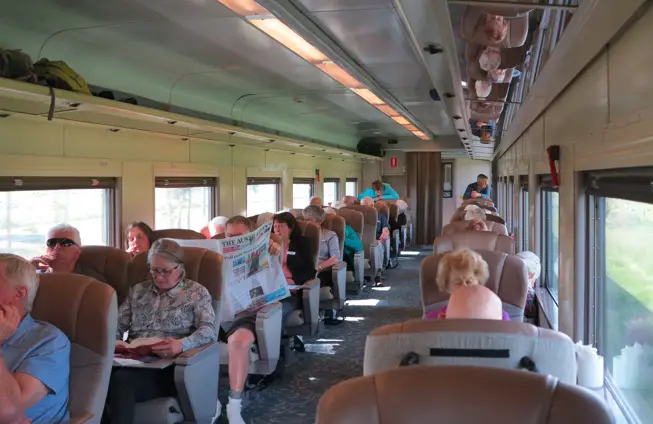
There are two classes of travel available. Great Southern call them:
- Red Standard and
- Red Premium (photo here)
- Red Premium has three seats across in each row (two on one side of the aisle, one on the other) compared to four across in Red Standard,
- Red Premium has more legroom (mind you, unless you own your own airline, even Red Standard has more legroom than any airline you’ll ever fly).
- Red Premium includes all meals and snacks served to your seat whereas in Red Standard, meals are not included, but there is a café bar car which you are free to visit and purchase meals and snacks. You can also stroll around the train and even sit in the booths or tables in the café car.
Before you travel
Great Southern Rail have a check-in process, similar in some ways to airlines, that requires you to be at Southern Cross Station half an hour before the train’s scheduled departure. So, given the morning departure time, if you want a relaxed morning, consider staying overnight in a hotel the evening before your departure.
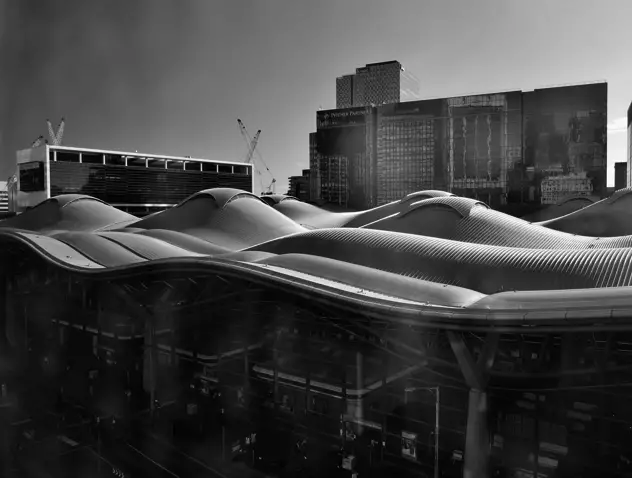
I recommend the Vibe Savoy. If you get a West facing room (maybe you can ask for one), you may even get a rare view across Southern Cross station’s unusual wavy roof, and perhaps you might even see “The Overland” train itself arrive on the nearest platform the evening before your trip.

There are other hotels nearby too, though not quite as stunningly close to the Overland’s departure platform as is the Vibe Savoy. Whilst I’ve not personally stayed at them, some of the other nearby accommodation options are:
Finding and Boarding your Train
Whether you stay overnight at one of the nearby hotels above, or whether you arrive by train, tram, bus or taxi, you should ensure you arrive at Southern Cross station with enough time to spare to check in. For ‘The Overland’, Great Southern Rail ask that you arrive at least 30 minutes before departure time.
‘The Overland’, in our experience normally departs from platform 2. But, please check one of the many electronic displays around the station because it theoretically could depart from platform 3 if needed.
Platform 2 is the first platform that you will see if you enter the station from the Spencer Street side. Before you ask, yes, there is a platform 1 – but it is tucked away beneath the shopping centre a little further north, and platform 2 extends further south so it really is the main platform.
Don’t be put off by the size of the station – platforms are numbered up to platform 16, but platform 2 is definitely the easiest one to find. They are numbered in sequence, so if you come from the west you’ll see platform 16 first, just keep walking and you’ll eventually get to platform 2.
If you’re coming from the Vibe Savoy or other hotels across Spencer Street, you have street level access to the train – just walk from the street and platform 2 is right there in front of you.
If you’re coming from the west, you’ll be on a bridge and you will have to descend to ground level. There are steps from the northern bridge, but the only escalator at the north end takes you up, there is no down escalator. However there is a Lift just near the top of the steps. If you come across the southern bridge there are two sets of escalators that will take you down to train level.
Once you’ve found platform 2, you need to find the entrance gate. This is located about mid-way along the platform virtually beneath the steps and escalator from the northern overbridge. There will probably be a Great Southern Rail employee at the gate (in khaki/beige uniform and maybe an Aussie broad brimmed hat) to greet you. Note that you will need a printed version of your ticket to show the employee here. The train staff member will check your ticket, advise you of your carriage and seat number, point you to where the train is waiting and they’ll let you through the gates. Seat numbers work much as they do on aircraft, but instead of a row number and a seat number as you have on aircraft, here you get an alphabetic carriage (car) number (A, B, C etc) and a numeric seat number (1,2,3 etc).
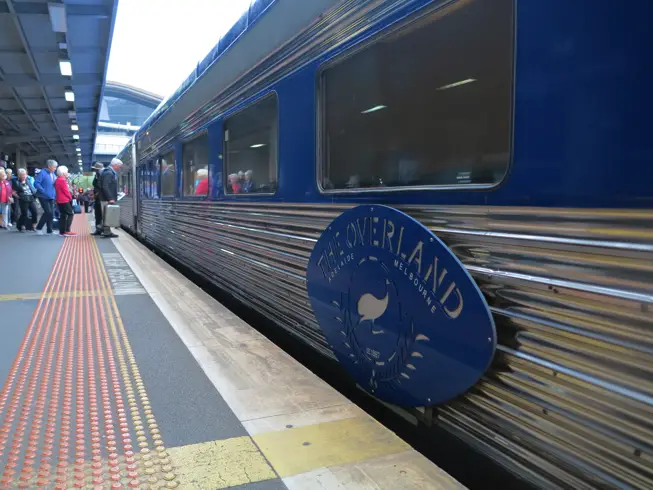
Find your seat, stow your bags and settle in. Seat numbers are displayed on the the walls above the windows. Note that your seats rotate – so if you are travelling with companions, or if you prefer to face backwards when travelling, or if you have been assigned a limited visibility seat near a bulkhead you can rotate your seat and travel backwards. Simply press the release pedal with your foot and swing the seat around until it clicks into position.
Before we Depart
In the few minutes before departure you can familiarise yourself with your seat, the carriage and your travelling companions. You will see the busy Southern Cross station in action with other passenger trains arriving and departing outside your window. If you're on the left side of the train, you’ll see VLine passenger trains arriving and departing bringing commuters into Melbourne from regional Victoria. VLine trains are quite striking in their purple and yellow colour scheme (sometimes called Violet Crumble). They are also well patronised because they run fast, frequent, reliable and inexpensive services into Melbourne from many parts of Victoria. This will probably not be the last time you see VLine trains today, and if you keep reading I’ll point them out to you when the time is right.
On the right of the train, you may see the elusive platform 1. Depending on the day and the timetable, you might see one of the two daily XPT trains arrive in platform 1 from Sydney. This is another of Australia’s great train journeys, but there’s an entire other essay to be written on that trip. Suffice to say, if you enjoy this trip on The Overland, consider taking the XPT between Melbourne and Sydney next.
We’re Away!
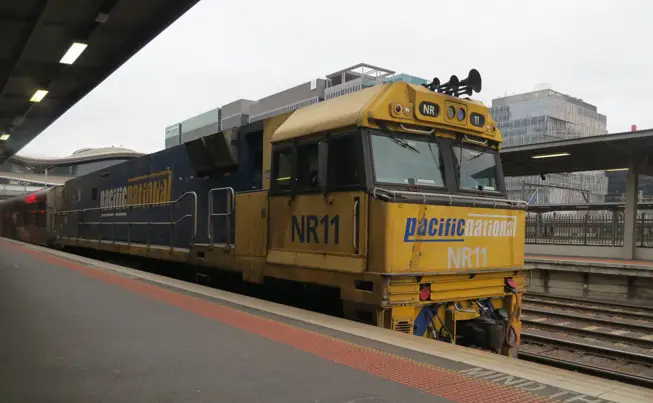
At the appointed time, the locomotive horn will sound, its bell will ring and the train will gently pull away from the platform. Before you jump to conclusions, I should point out a couple of things. You may think ‘gee this train is travelling pretty slowly’. Yes, initially it does travel slowly, but rest assured this is only for the first few km through the twisty and complex rail yards and industrial depots of Melbourne’s western suburbs. It does speed up greatly after about the first 20-30 minutes.
Secondly, and this is related, you may notice a moderately loud banging or grinding sound coming from beneath the carriage. This is caused by the bogie, or wheel-frame, twisting side to side to navigate curves in the tracks. Once again, this will last only for the first few minutes, and once the train gets away from the twisting tracks and onto the straight main line it will calm down a lot.
Through the Window
For the first half hour or so of our trip, we’ll be travelling through Melbourne’s industrial western suburbs. To be quite frank, it’s not the most scenic route into or out of the city, but, there’s plenty to see.
As we leave Southern Cross station’s cavernous roof and bustling platforms, we travel past Melbourne’s famous ‘Festival Hall’ on the right. Sometimes known as the ‘House of Stoush’, this gritty old venue was for many years the home of televised live boxing and wrestling. It was also Melbourne’s premier music concert venue and hosted concerts from the world’s best including: The Beatles, Shirley Bassey, Roy Orbison, Buddy Holly, Bill Haley and the Comets, Liberace, Frank Sinatra, Johnny Cash, Joe Cocker, Johnny O'Keefe and the Sex Pistols. Whilst its salad days are behind it, Festival Hall still hosts concerts today.
The train climbs the North Melbourne flyover and travels high above the mass of railway tracks carrying suburban electric trains between North Melbourne and Southern Cross stations. Then we cross the Moonee Ponds Creek and enter a heavily industrial area that houses railway locomotive depots, container yards and transport and shipping facilities. The train may pause here for a minute or two to enable rail staff to board or to allow other trains to cross over the tracks. This area is adjacent to the Port of Melbourne, Australia’s busiest port. It is a hive of activity with trucks, trains, cranes and ships transferring vast amounts of cargo. It never ceases to amaze me how high the shipping containers are stacked.
A few minutes later and our train crosses the Maribynong River, Melbourne’s second river, and then we enter the Bunbury Street tunnel. This takes us beneath the cosmopolitan inner suburb of Footscray and under two major railway lines. This is the last tunnel we will travel through today until much later in our journey – by which time we will be within an hour of arriving in Adelaide.
Once we emerge from Bunbury Street tunnel, we travel for a few km parallel with the suburban railway line that carries electric trains to Sunbury, and with the main ‘Regional Rail Link’ tracks that carry VLine passenger trains between Melbourne and Geelong, Ballarat and Bendigo and points further afield. If you are on the left side of the train you may see some of these trains pass by and you may see three suburban stations: Middle Footscray, West Footscray and Tottenham. At Tottenham, again on the left, we traverse the large and now largely disused Tottenham railway yard formerly used to shunt and marshal goods trains to and from country Victoria.
Once Tottenham yard is behind us, we pass through one of Australia’s most significant railway junctions. Until this point, since we departed, we’ve been travelling on the same track as trains to and from Sydney, but here, our train turns left onto the western line to Adelaide, Perth and Darwin, while the main East Coast line to Sydney and Brisbane curves away to the right. Immediately after the junction, we travel high above the suburban railway and roadway on a curving modern concrete bridge that points us south for the short leg through the industrial suburbs of Brooklyn and Spotswood. Once again, you’ll note the heavily industrial nature of the area – which is of course largely why the railway runs through here.
A few minutes later we reach Newport where we run behind the suburban station (which we can see on the left), then the train takes a wide right hand turn to head south-west. On the left we pass by the historic Newport Railway Workshops – the home of the former Victorian Railways. This was where so many of the steam locomotives, carriages and wagons that transported Victoria were built and maintained for so many decades. Today, it’s been transformed into a range of community facilities, but is still used to store modern trains between shifts, and also houses a large number of retired and historic trains and trams.
Now we start to speed up
We now largely leave behind the twisting industrial part of our trip and the train can stretch its legs (metaphorically) on what is basically a straight main line. At this point, we are running parallel to the suburban railway to the south-western suburb of Werribee, and on the left you may see a number of stations and electric trains for the next few km.
On the left is a railway junction for the suburban railway to Altona. There are two separate suburban railways to Werribee – one travels via Altona, the other takes a more direct route parallel to our route. As we pass by an oil refinery, you may notice an abandoned suburban station platform – Paisley station closed in the 1980s. A minute or two later another – Galvin. Today, Werribee line trains don’t call at Paisley or Galvin. After a few minutes as we re-join the line from Altona, on the left you may see a suburban electric train running through fields on the indirect line via Altona. On weekdays, trains via Altona only run as far as Laverton (we’re just about there), and Werribee trains run alongside our track, but on weekends all Werribee trains run via Altona. As we whizz past Laverton station you might see a Laverton via Altona electric train stopped in the platform waiting to return to Melbourne.
Pro Tip - Where are we?
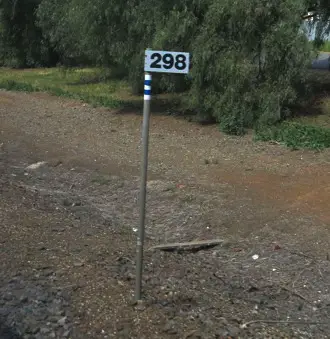
Leaving the suburbs
Just after the 31km post, we pass by Werribee station (on the left). This is the last station on Melbourne’s suburban electrified network, and is traditionally where Melbourne’s suburbs are considered to end. However, as we travel onward you will notice the extensive suburban expansion that is taking place beyond Werribee. It is only a matter of time until electric trains will be extended beyond Werribee. Note also the pair of tracks running parallel to us on our left. These tracks were formerly the main VLine route to Geelong and South-Western Victoria, but since 2015, when a brand new route, (Regional Rail Link) was constructed further north, these tracks are not regularly used for passenger trains and now see only infrequent freight and special trains. It’s pretty obvious that they will one day be electrified to transport the residents of all the new houses in this area.
As we near the 40km mark, on the right you will be able to see the new Regional Rail Link route approach from the North. It flies over our train and junctions onto the rarely used tracks from Werribee. Now, it's likely you will see VLine trains travelling on these tracks as we head further south. This is the main VLine route to Geelong. It carries heavy commuter traffic to and from Victoria’s second city. On weekdays there is a VLine train every 20 minutes each way, and on weekends there is one every 40 minutes each way.
After the 47km mark we pass the station at Little River. This is a very small town that is really the only rural location between where suburban Melbourne ends and suburban Geelong begins. The station, built of local ‘bluestone’ (dark volcanic stone) has been retained pretty much in original condition and is the most impressive building in the town.
After the 57km mark we pass Lara. This is effectively the start of suburban Geelong. You can see that whilst Melbourne and Geelong are separate cities, they are not that far apart, and they are growing closer together. Lara is really only even slightly famous for just one thing: it was the setting for the town of ‘Dunt’ in the controversial ABC TV comedy/satire series ‘Angry Boys’ starring Chris Lilley. In fact, Lara railway station featured as Dunt station. You can just about visualise Nathan and Daniel ‘dam surfing’ here.
Geelong - Victoria's second city
After North Shore, we take a sharp right hand turn and leave behind the main VLine Geelong railway, and head west.
As we navigate the sharp right hand curve, look out the left side window and you will be able to see in the distance downtown Geelong. Just beyond that you might also see the modern light towers at Kardinia Park, the home ground of the Geelong AFL team. As we leave the curve, also on the left you will see an old signal box labelled "North Geelong C". This is one remnant of the once extensive manual mechanical signalling complex in place serving the shunting and marshalling yards in the north of Geelong. Today, with the advent of 'block' trains that require much less re-marshalling, such relics are now obsolete, but it's comforting to see some of the old signal boxes preserved.
For the next few km, from here until we reach Gheringhap, we are, unusually, travelling on dual-gauge track. Our train is travelling on international standard gauge track - 1435mm gauge. But this route also carries Victorian broad gauge (1600mm) trains. There is a long and sad history of how Australia's railways came to be built to so many different track gauges, but sad to say we still to this day suffer the consequences. If you could look beneath the train right now, you would see three rails - one on one side and two on the other,
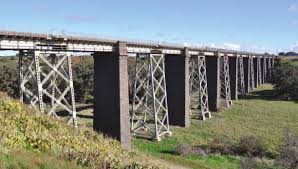
We reach Gheringhap at 83km. Gheringhap (pronounced JERRing-HAP) is a railway junction at which the Victorian broad gauge track to Ballarat diverges from our path on the right and heads away to the north-west. This track was the original main line between Melbourne and Ballarat, but is today a secondary route that carries only goods trains. It does bring grain by train down from north-western Victoria for export through the port of Geelong. From here on, we are on regular standard-gauge track.
The "Pleurisy Plains"
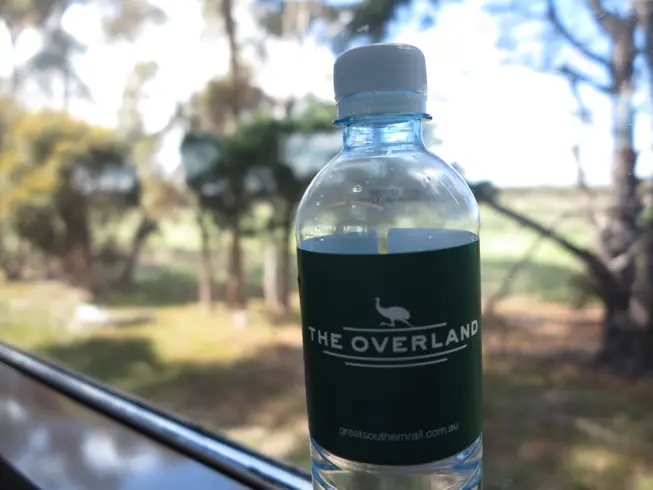
At 137km we reach Cressy. There's not much here these days, but in decades gone by this was a significant railway junction. There were four railways into Cressy and a large station sat at their confluence. It's hard to believe today. Just before town, if you look very carefully out to the left you will see the formation of the now long-closed railway from Colac curving in from the South-East. Then, as we speed through Cressy itself on the left you might spot all that remains of this once great railway junction - a large re-created 'Cressy' nameboard planted in the weeds beside the track. Then, just after the town, on the right as we cross over the main road, you might see the formation of another long closed railway curving away to the north - this once ran up to Ballarat via Newtown and Smythesdale. When this cross-country line from Colac to Ballarat closed in the 1950s, Cressy lost its status as a junction station and is today really not much more than a handful of houses and perhaps a tennis court.
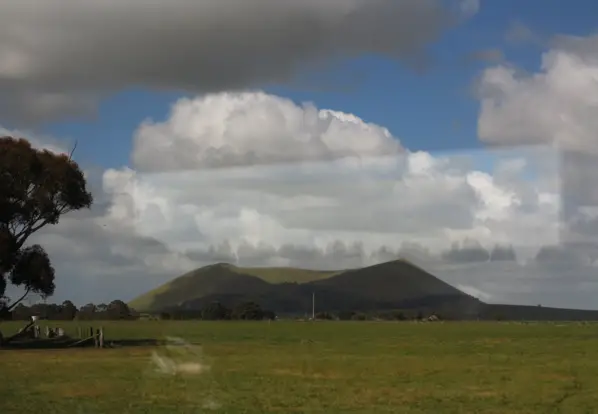
Very soon we pass through more remnants of indigenous language preserved in town names. Some indigenous languages use repetition to signify strength or great quantity. Unusually, the next three stations or former stations are all double-names that take from this tradition.
- At about 185km we pass Vite Vite,
- then at 195km we pass Pura Pura
- and at 204km we pass Nerrin Nerrin.
Gariwerd and Gum San
After we speed past the small towns of Westmere at 213km and Tatyoon after 231km, we reach another railway junction just after 243km. On the left, sweeping in from the south-west you might see aanother railway line swing in and join us. This is the railway from Hamilton and Portland in Victoria's south-west. This line sees freight trains carrying stone and grain from NW Victoria (rocks and seeds as some refer to them). We immediately then pass by the remnants of Maroona railway station on the train's left hand side.
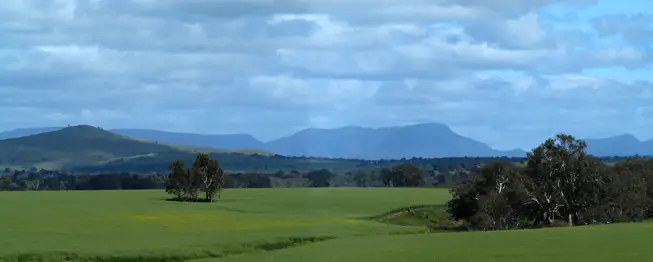
Bubbly and The Gift
Now that we've departed Ararat, the distance posts now measure the distance from Melbourne via the shorter route via Ballarat. So, even though we've travelled about 260km, the km posts are back to 212km. Don't let it bother you, this happens sometimes.
As we reach the 226km mark we reach the small town of Great Western, founded by two Frenchmen who came to Australia during the Gold Rush, the town is now famous as the Australian home of sparkling wine. Great Western is focussed on the massive Seppelt winery that specialises in wine modelled on French Champagne. The railway travels right through the middle of the Seppelt vineyards, and passes immediately past the front door of the winery. Watch out for the vineyards on both sides of the train, and the winery itself on the left.
Shortly after, at 241km, we arrive in Stawell, our next passenger stop. Stawell, (pronounced 'Storl'), is famous as the location of the 'Stawell Gift'. Held every Easter since 1878 (except during WWII), the two day event had in the past been billed as the world's richest professional footrace. That's perhaps not quite as impressive as it may sound because professional foot racing was not common around the world while the Olympics insisted on amateurism, but in the past 30-40 years it has been surpassed by other events. It does however remain Australia's most prestigious footrace. The event is staged at Central Park which is immediately adjacent to the railway station. You can see the venue from the right hand side of the train.
After departing Stawell, we leave the goldfields behind and head into the very heart of Victoria's grain growing region. Known as the Wimmera, this region is flatter and drier than the countryside we've been travelling through until now. It is ideally suited to growing wheat, oats, barley, canola, and broadacre crops. Depending on the time of year you will see all of these crops growing in fields alongside the track. In Springtime, the bright yellow canola fields are quite spectacular. Perhaps the most iconic features of this part of the country are the massive grain silos that erupt from the landscape every few km - usually alongside the railway line. If you're travelling after harvest time, typically December to March, you may see bulk grain trains being loaded from these silos as you pass by.
Lubeck is reached at 281km. The name Lubeck is quite obviously of German origin reflecting something of a German influence in the Wimmera region we're now entering. Lubeck was, until 1983, the junction for a now closed railway to Bolangum, the remains of which you can see curving away on the right hand side. After we leave Lubeck, in the distance behind us on the right you can see the grain silos at Jackson, the first station out along the closed Bolangum railway.
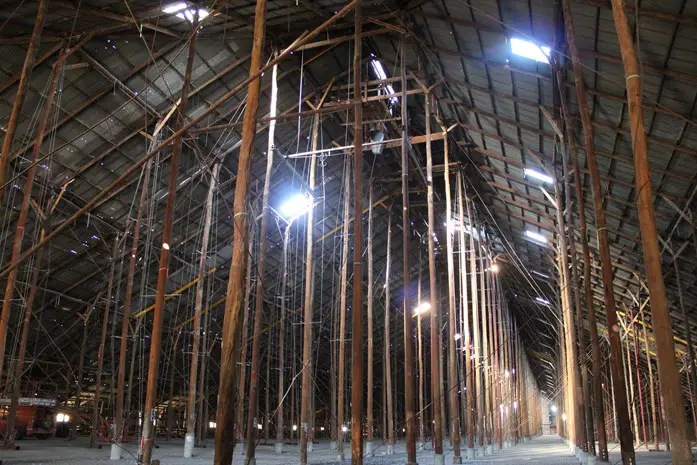
Wheat, Oats and Barley
We're now really in grain country, and every tiny little place we pass through has a large grain silo. These impressive structures, many of which were built in the early to mid 20th century dominate the landscape and are emblematic of the region's grain growing business. At 309km we pass Jung (another German name by the way, but here it's pronounced with a hard 'J'). There is a particularly impressive set of grain silos here which can be seen from the right hand side of the train.
At about 315km, on the right hand side you can see a railway freight yard. This is quite a new facility that is just about the only general rail freight yard that now operates anywhere between Geelong and Adelaide. It is the hub for containerised freight to and from Western Victoria, and is served by regular container trains to and from Melbourne. You will likely see wagons and even a train in the process of loading or unloading here. Next up at 319km is Dooen. Pronounced DOO-en, you will once again see an impressive grain silo from the right hand side of the train.
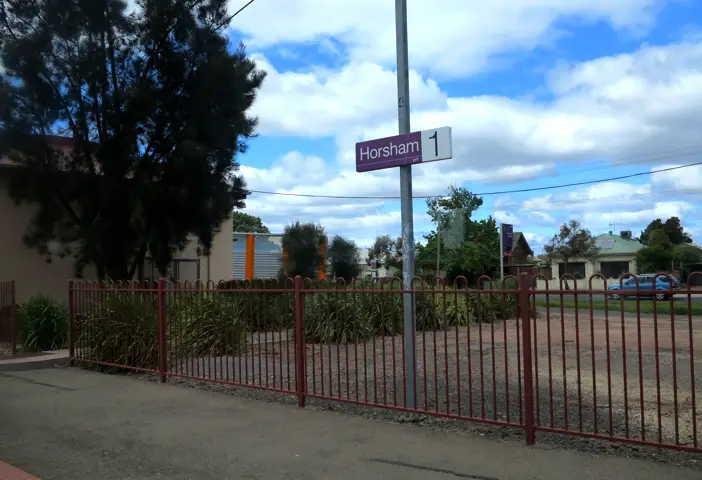
West Wimmera
As we leave Horsham behind, with every kilometre we travel we are getting into ever more dry, arid and less fertile countryside. This will be an ongoing theme for the next few hours until the trend turns as we get closer to Adelaide. More on this later. But right now, we're in the sweet spot of grain growing country. As we parallel the main Melbourne to Adelaide roadway (highway 8), we pass a series of grain sidings and silos at
- 336km: Dahlen (best seen from the left side of the train) - named for the Dahlenburg family who were local settlers from Saxony
- 345km: Pimpinio (PIM-pin-EYE-oh) - an indigenous word meaning 'children'
- 352km: Wail - another indigenous word, meaning Curlew bird. At Wail there is a paricularly impressive double sized gain silo complex on the left side of the train.
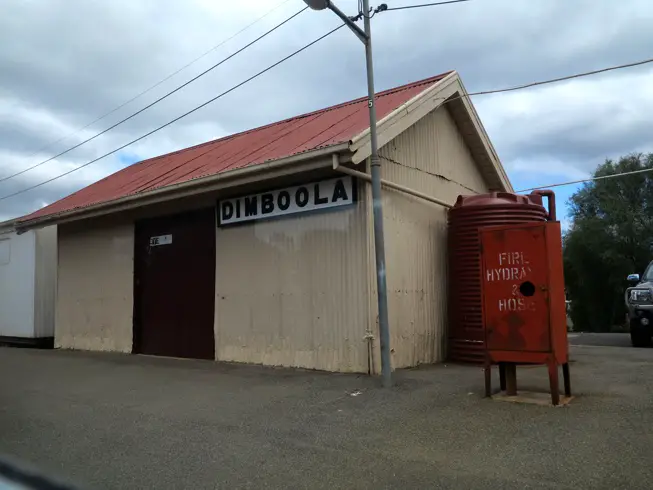
As we head west from Dimboola we parallel the main highway on our left. At 370km on the left you'll get a great view of Pink Lake. This is a salt lake which, when you see it, you'll know why it got its name. After Pink Lake we pass by three more grain silos at
- 378km: Gerang Gerung (pronounced jer-ANG jer-RUNG)
- 386km: Kiata (ki-ATTA)
- 392km: Salisbury
At 399km we reach our next stopping place, our last in Victoria. The small town of Nhill (pronounced 'Nil') appears on the surface to be a standard wheatbelt town, but, Nhill is different. Blessed with two significant employers - a flour mill and a duck processing factory, both of which have been in need of employees, Nhill has attracted a significant population of Karen people, most of whom were refugees from Myanmar. Something like 10% of the town's population is of Karen background and Nhill is an example of how Australia can build its regional population and employment base whilst meeting humanitarian obligations at the same time.
On departure from Nhill, we head on further west past the small silo sidings at
- 411km: Tarranginne
- 417km: Diapur
- 428km: Miram
After Kaniva we press ever westward. At 447km we pass Lillimur (LILL-amar). We're now getting very close to the State border, but, it's not quite as clear cut as you might think. The original definition of the border between Victoria and South Australia, determined in 1836 was that it was to be a straight line that follows the "141st degree meridian of longitude east of Greenwich". That is the same meridian as the border between NSW and SA, and also the lower part of the border between Queensland and SA. But, we pass the 141st meridian at about the 461km mark - yet, we're still in Victoria. What happened? In fact it was a surveying stuff-up that led to the border being too far west. The Vic/SA border is about 3.3km further west than it was supposed to be, and 3.3km further west than the NSW/SA border. This even led to a dispute between the two States that was only resolved in 1914 after it had risen to the High Court and eventually the Privy Council in London.
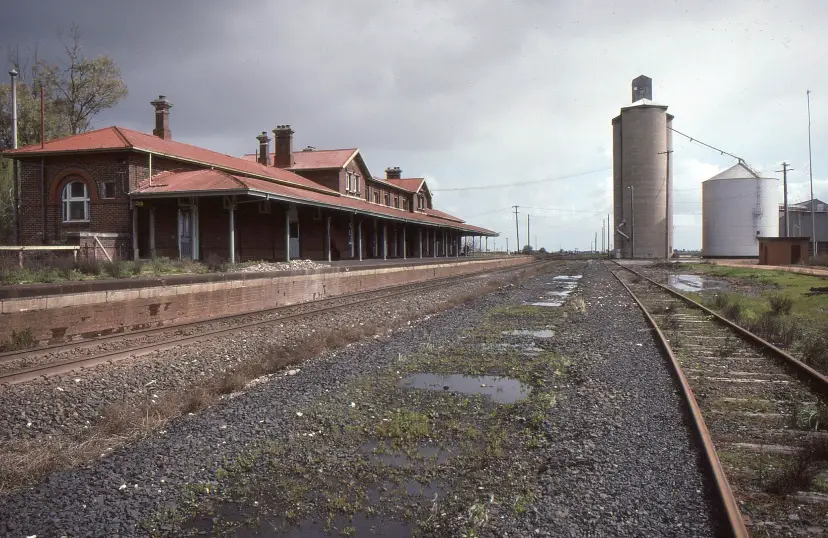
South Australia - Heave Away Haul Away
Welcome to South Australia. A couple of practicalities. First up, we are now in a new time zone. South Australia follows Australian Central Time which is 30 minutes behind Australian Eastern Time. So, re-set your watches now. Of course you may rely on your mobile phone to auto-set the time, but a word of warning, it can sometimes take quite a while in this area before your phone determines it's in a new time zone - up to 15 or 20 minutes. So, be a little careful about relying on mobile phone time for the next little bit.
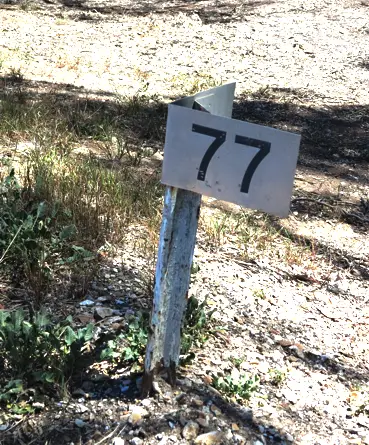
For the first few km in South Australia, until we reach the town of Wolseley, we travel on track that exemplifies Australia's railway track gauge woes. It has at various times in its history been built to three separate gauges. In 1887 the line opened as a broad gauge (1600mm) railway. For a short time, the track was dual gauge broad and narrow (1067mm) when an extension of the narrow gauge line from Mount Gambier to Wolseley was run to Serviceton. The narrow gauge was removed from the Wolseley to Serviceton section some time later, leaving this line as broad gauge only. Then in 1995 the main line was converted from broad gauge to standard (1435mm) which is the way it remains today.
The first South Australian town we pass through is Wolseley at 307km (from Adelaide). You can see the remains of the now closed Mount Gambier railway curving in on the left hand side as we enter the town. Whilst the railway station here has been known as Wolseley since the railway opened, the town that surrounds the station was, originally known as Tatiara (TATTy-AR-a), but was in 1941 re-named to match the railway station. They had their priorities right in those days.
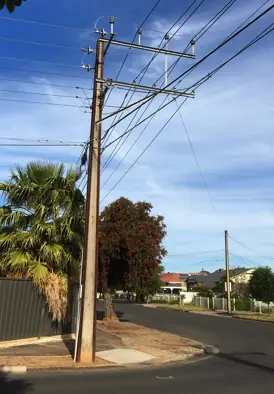
Drier and Drier and Drier
Just after the 295km post, we arrive at our first passenger stop in South Australia. Bordertown, named obviously but not entirely appropriately for the State border, is a smallish town whose primary claim to fame is that is was the birthplace of Bob Hawke, an Australian Prime Minister from the 1980s. Note the railway station building on the left hand side of the train. It's very different to the style we were seeing in Victoria. This striking and flamboyant station was built in 1914 in what has been described as American Art Nouveau style. The building is not used for railway purposes these days, and has clearly seen better times, but it is evocative of a time when railway buildings were seen as a way for authorities to display their civic pride.
When we leave Bordertown we head through more grain growing country, but you will notice that the country very rapidly becomes drier, more scrubby and less arable. We pass through small grain towns at
- 273km: Wirrega
- 249km: Keith
- 228km: Coombe
- 212km: Tintinara (TIN-tin-AH-ra)
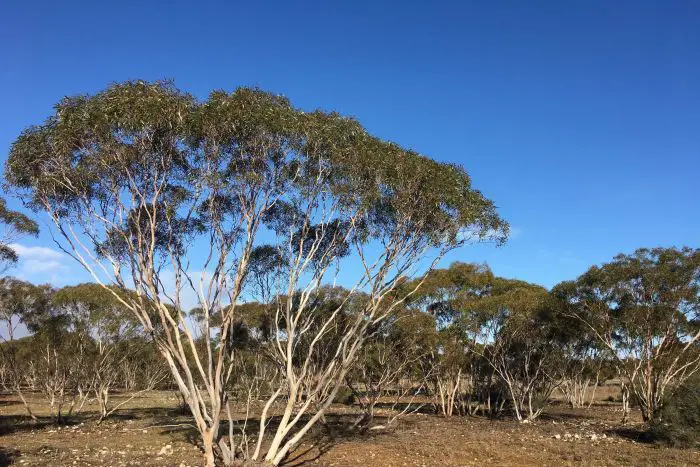
But, just as things were teetering on the edge of desiccation, the trend changes. Around the 123km mark we approach the town of Tailem Bend. Once a major railway town, and junction for TWO railway lines into the true heart of the Mallee country off to our right, Tailem Bend is nowadays turning its focus onto something quite different. On the right hand side of the train you will see a very large and quite new solar power farm that harvests a resource that this part of the country has in abundance. As we roll through town without stopping, the largest town along the route that we do not call at, notice the extensive railway yards on the right hand side of the train, and another of the American Art Nouveau station buildings on the left side. What you cannot see, just out of view on the left, is that Tailem Bend is in fact situated on the banks of Australia's largest river - the Murray. In fact, the town is named after a bend in the great river, and this is where the water in all those pipes has been coming from.
The Hills are alive
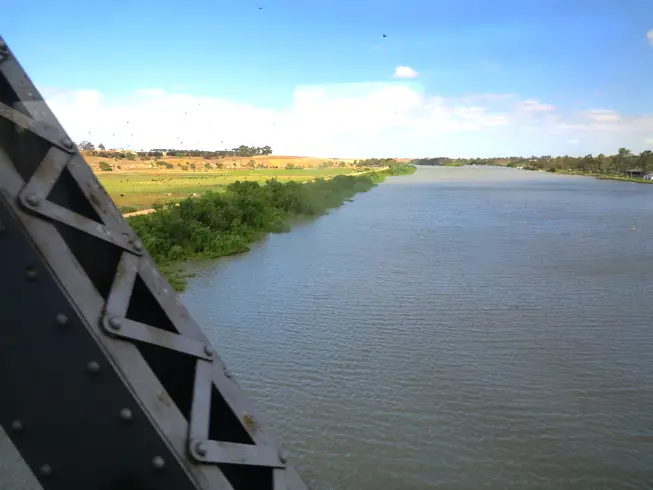
After departing Murray Bridge, pretty much everything changes. Instead of the countryside getting flatter and flatter and drier and drier, it gets hillier and hiller and wetter and wetter. Well, it doesn't get really wet, but by the standards we've experienced today, the sight of European deciduous trees is unexpected - but that's what lies ahead. And for the next 65km we will be climbing almost continuously and the track will be winding back and forth through the hills.
At 82km we pass Monarto. This is the last grain silo on the route as we are now leaving grain country behind. It was also the junction for a now closed branch line railway that once ran north from here to Sedan and Cambrai. At around 72km we pass through the village of Callington, then near the 68km post from the right hand side of the train you can see a very large open cut mine known as the Kanmantoo Copper Mine.
At around 56km we pass through the town of Nairne. It's starting to feel slightly more European now. Around the 50km mark we pass by the abandoned Mount Barker Junction station. This was formerly the junction for a railway line that ran down to the coastal towns of Goolwa and Mount Barker. The death sentence was dealt to this line when the main line on which we're travelling was gauge converted to 1435mm in 1995 leaving the 1600mm gauge branch line isolated. However, not all was lost, and there is an active heritage steam and diesel railway that operates trains along almost all of the railway on a regular basis. It's a great experience - you just can't get to it by train!
Shortly afterwards we pass through the town of Balhannah, and then at about the 45km mark we pass through the Balhannah tunnel. This is the first of a number of tunnels over the next few kilometres. We keep winding and winding and climbing and climbing until at the 31km mark we reach the summit at the appropriately named Mount Lofty. This is the part of your journey where you're most likely to be able to catch a glimpse of the front or back of our train as it navigates the sharp curves.
From here on, it's all downhill and into Adelaide. Just after 23km we pass Belair. This is where Adelaide's suburbs nominally commence. The historic railway station is visible out the left hand side, but on the right you will see the modern station that signifies the start of Adelaide's suburban train network. From here on, we run parallel with the broad gauge suburban railway, and it's quite probable that you will see some of Adelaide Metro's bright yellow or red suburban diesel railcars that serve the Adelaide to Belair route.
Down, down, down, past the suburban stations at Pinera, Glenalta and Blackwood (all on the right hand side), and through more tunnels we pass. On the left hand side you will get some spectacular glimpses of the city and suburbs of Adelaide, and the Gulf of St Vincent beyond. A continuous steep downhill run takes us through more tunnels, then past Eden Hills station and at about the 13km post, into the long Eden Hills tunnel, then suddenly, we emerge into inner suburbs. We run past suburban stations at Linton, Torrens Park, Mitcham, Unley Park and Millswood before arriving at Goodwood junction which is where the busy electrified suburban railway to Adelaide's south-western suburbs joins us from the left and passes beneath our train. From here, its a short run up past Goodwood and Adelaide Showgrounds stations on the right, before we reach our destination at Adelaide Parklands Terminal.
Adelaide Parklands terminal isn't particularly spectacular, nor is it conveniently located to anything really. It was opened in the early 1980s as a new terminal for long distance trains so that they didn't need to travel into the wonderful old Adelaide station in the heart of the city. Nonetheless, the terminal does its job, and it's very easy to disembark here, collect your luggage, and board a taxi which will be waiting very conveniently located just 10 to 20 metres from your carriage door.
Unlike in Melbourne, there is no hotel or other accommodation located within easy walking distance of Adelaide Parklands terminal, and it's not easy to access suburban trains from here. Unless you're prepared for a really long walk, a taxi is the best bet. It's only 2 or 3 km into the heart of the city, so it won't cost too much. Station and train staff are also very happy to help organise shared taxis that can reduce the cost even further.
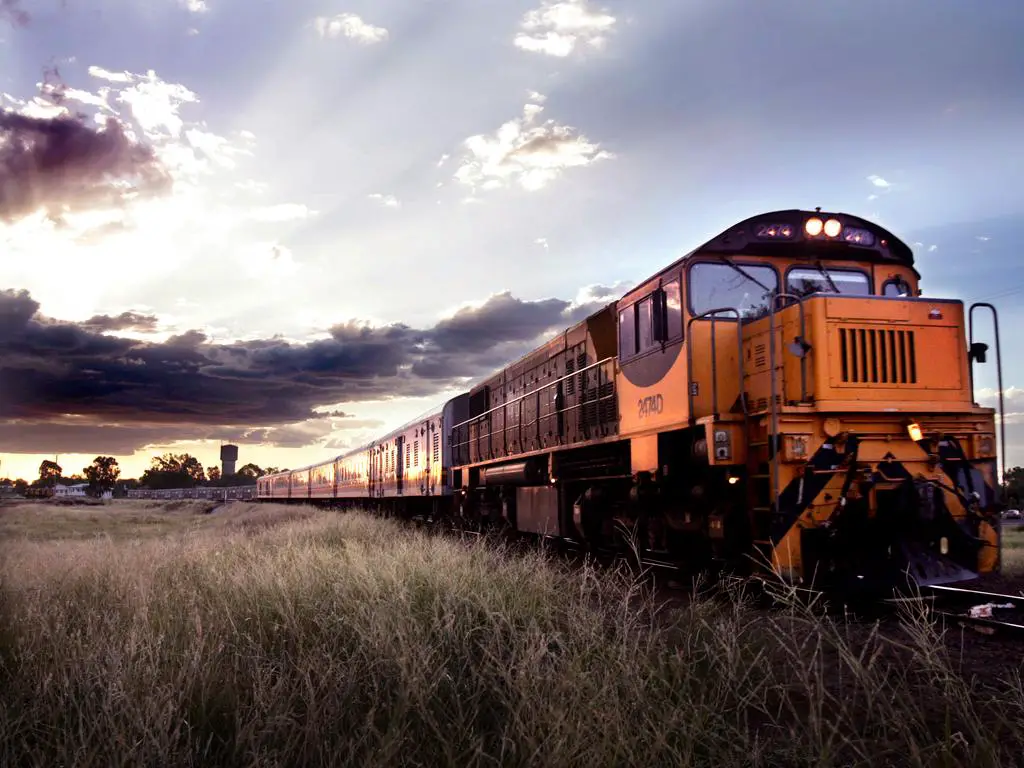
- Onboard Experience
- Train Journeys
- Holiday Packages
- Train & Cruise
- Train Journey
- Before You Go
- Frequently Asked Questions
- Stations & Terminals
- Travel Update
- Special Offers
- Join The Travel Club
- Newsletter Sign-Up
- Rail Holiday Brochures
- Journey Beyond Group
- Gift Vouchers
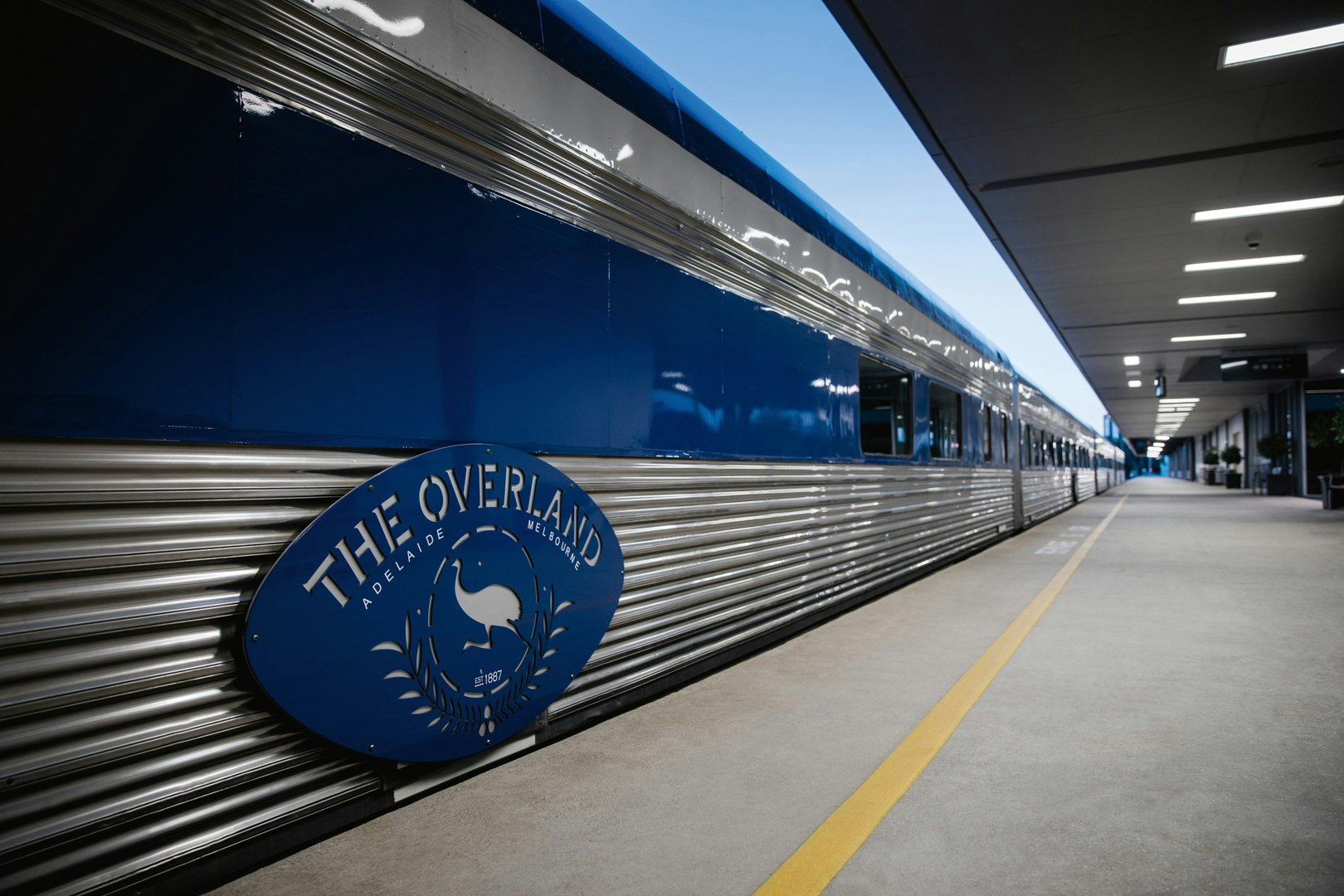
THE OVERLAND
Adelaide and melbourne, departing adelaide sun & thur departing melbourne mon & fri.
A day trip in a league of its own. Ride the rails of romance on your next interstate adventure with this day-long train voyage aboard the Overland.
Still the best way to travel between Adelaide and Melbourne, the Overland offers two levels of service. Red Service offers a value for money choice, and Red Premium provides all-inclusive dining- whatever your choice, you’ll have plenty of room to move and the chance to meet fellow travellers in a comfortable, friendly environment. With comfortable, reclining seats, generous legroom, up to 60kg of luggage allowance and dedicated hospitality attendants to tend to your every need, The Overland offers service in a class of its own.
*Important note, d ue to railway possession, the following Overland departures will be travelled by coach.
- Sunday 25 th August, Adelaide to Melbourne
- Monday 26 th August, Melbourne to Adelaide
For any enquires, please contact us on 13 21 47.
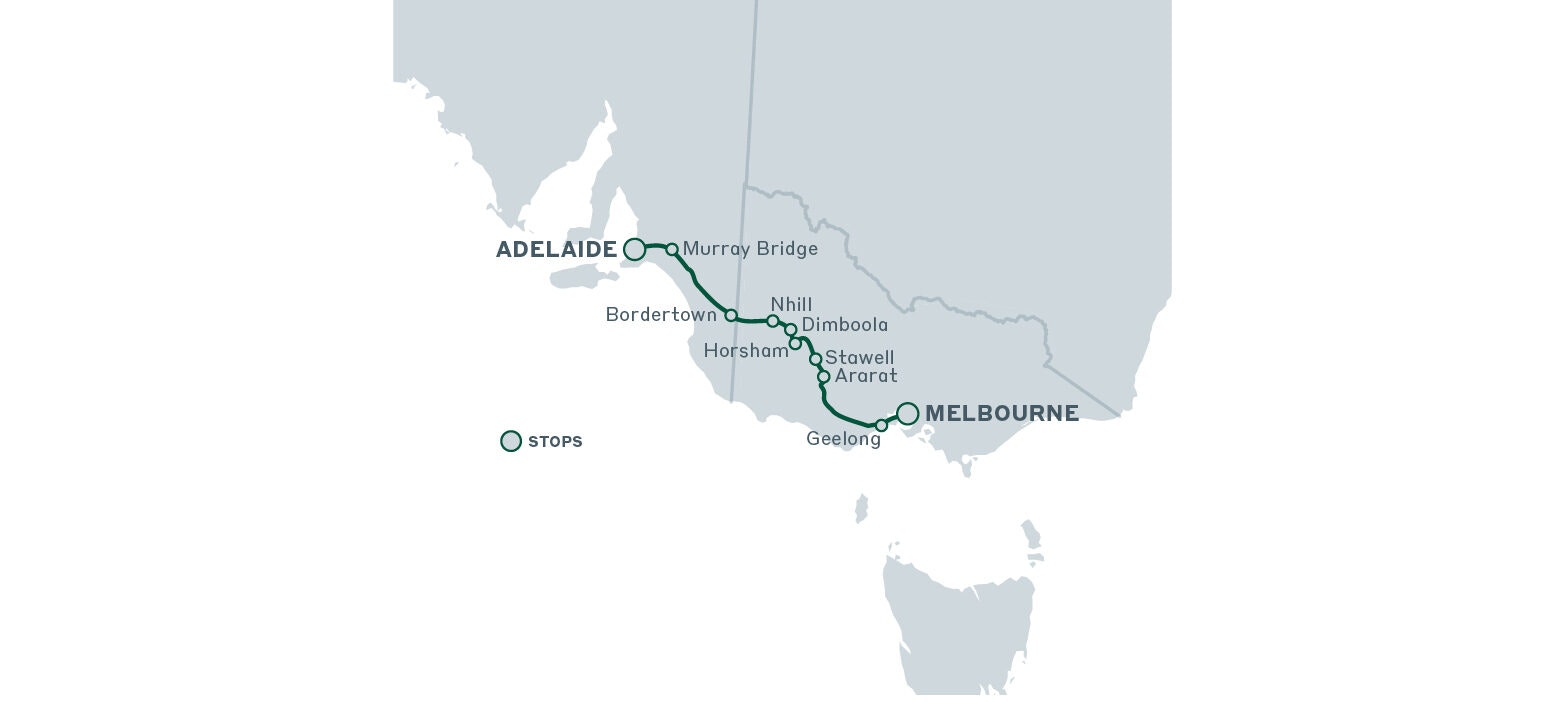
Ready to book?
To see all available options for The Overland, please press the button below to be redirected to our online booking engine.
Great Southern Rail Journeys are only available in January and December
To book this package please call or email [email protected] .
Overland travel between Melbourne and Adelaide

- 1 Understand
- 4.3 By train
- 5.1.1 Melbourne to Ballarat
- 5.1.2 Ballarat to Ararat
- 5.1.3 Ararat to Horsham
- 5.1.4 Horsham to Bordertown
- 5.1.5 Bordertown to Tailem Bend
- 5.1.6 Tailem Bend to Adelaide
- 5.2.1 M1 - Melbourne to Torquay
- 5.2.3 A1 Warrnambool to Mt. Gambier
- 6.1 South-East/Dukes/Western
- 6.2 Princes/Great Ocean
- 6.3 The Coorong/Limestone Coast/Great Ocean Road
- 7 Stay safe
Going overland between Adelaide and Melbourne , whether by car, bus, or rail, may take longer than the quick 45-minute flight, but has advantages for the traveller. Going this way, you can see a lot more of the country's scenery and check out plenty of small towns you may otherwise overlook.
The Dukes/Western/South-Eastern (M8/A8/M1) is a direct route going through many of Victoria's historic goldrush regions. This route is 725 km long, and will take a minimum of 7 hours without stops.
The Princes Highway/Great Ocean Road (A1/B100/B1) is an oceanside scenic route popular with tourists since the 1930s. It is roughly 1000 km, and will take at least 12 hours without stops, but realistically a fair bit longer. An even longer route goes through The Coorong and the Limestone Coast on the way out of Adelaide towards the Victoria border and Great Ocean Road, but passes through some really scenic places on the way; give yourself at least three days if you want to take this route.
Understand [ edit ]

Melbourne is one of Australia's true world cities and a nexus of culture, art, food, and entertainment.
Adelaide is "Australia's largest country town", a city of nearly 1.5 million that endeavours to keep a bucolic and close-knit feel even as it expands into a metropolis. Though it isn't on every tourist's itinerary, it's a worthy destination for food, wine, and the "Mad March" festival season.
Both cities are relatively close-together in a country where driving eight hours often just serves to take you eight hours from civilization. Unlike the Outback routes or the Nullarbor , this is a fairly simple road trip with the same sort of considerations as any you might take in a similarly geographically large but more evenly distributed country such as the United States. Fuel and food are easily available at towns on the way, both 500-people dots on the map built primarily around a roadhouse and significant country towns where much of the surrounding region is in their economic orbit.
Prepare [ edit ]
You won't need much for this trip other than a bottle of water, or some snacks if you don't want to make potentially pricey meal breaks. Parts of the Dukes Highway get to 40˚C in the summertime and you will almost certainly feel dehydrated without water. A spare tyre is advisable, but not direly needed, since neither route has unpaved trails.
Get in [ edit ]
There are many entries to this route, with the most common ones being in either end of Melbourne or Adelaide.
Get around [ edit ]
By car [ edit ].
It takes about 7 hours end to end by car via the Western Freeway, the Western Highway, Dukes Highway and the South Eastern Freeway, but it takes 12 hours via the near coastal Princes Highway and Great Ocean Road without stopping. Realistically, it would take a lot longer as you'd want to stop somewhere at either destination whether it's for a drink of water or visiting some of the historic towns/cities.
By bus [ edit ]

Two bus providers serve this route, the Victorian state-based V/Line and the independent operator Firefly . The V/Line service is a combined coach and rail service, with trains between Melbourne and Bendigo followed by coach between Bendigo and Adelaide. Buses run both day and night services. Firefly is competitively priced, with regular fares around $65 to $70 and sale fares as low as $35.
The Firefly bus, day and night, runs the Dukes/Western route and stops at two roadhouses along the way: Ararat in Victoria and Tintinara in South Australia. Both are meal/rest breaks with about half an hour to get out and stretch your legs, rather than tour excursions. Ararat is a decently sized town with history in its own right, Tintinara more a pit stop built around the roadhouse. Ararat Roadhouse offers sandwiches, lasagna, and biryani night and day; Tintinara has a full-fledged menu for day service and a small selection of the kind of hot foods often prepared by service stations anywhere in the country, such as hot chips and dim sims. Tintinara Roadhouse also has quite a bit of local tourist information for the Limestone Coast plastered on the walls, and a television perpetually playing infomercials that gets outright liminal when you're there at 3AM.
The route taken by Firefly goes through a solid selection of other towns and small cities, particularly on the Victorian side of the border, and you can embark and disembark at a number of places other than Adelaide and Melbourne. The Ballarat station in particular sometimes sees more people getting on or off than the Melbourne one. It's a particularly convenient route if your origin or destination is in Melbourne's western suburbs , due to stops at Melton and Deer Park. In addition, unlike the rail alternative, you enter or leave Adelaide directly from the Central Business District.
This is not a luxury trip, although the free Wi-Fi is nice. In addition, while the bus is rarely crowded , it does see more passengers for its size than the train. It can be a fascinating place to people-watch, and conversations with strangers at the stopover points aren't uncommon.
By train [ edit ]
Interstate passenger rail travel in Australia is monopolised by Journey Beyond (known until 2019 as Great Southern Rail ), and your only real option to go between these two cities is The Overland . The Overland aims for a more luxurious form of travel than plane, bus, or car, even in Red (economy) class, while Red Premium (which can be rounded to a flight's business class or the nicer sort of premium economy) is quite the experience -- enough legroom to really stretch, plus tasty free breakfast and lunch (try the buffalo curry). It's a niche service that caters to a mix of retirees, families, and railfans, and carriages are rarely crowded or noisy. Though the ride is an enjoyable experience on the whole, significant bumpiness or 'turbulence' can happen over the rough terrain a lot of the track covers; this isn't usually an issue for a seated passenger, but it can be annoying while you're going to the toilet or getting a snack from the cafe carriage.
While JB/GSR's other offerings compare unfavourably in price to a flight, The Overland is surprisingly competitive in this respect, perhaps related to the fact it's funded almost entirely by the Victorian government. A Red ticket is comparable in cost to an economy flight on a budget carrier like Jetstar, while Red Premium is a little cheaper than economy on a full-service carrier like Qantas.
The big drawback of this mode of travel is that the trains don't offer Wi-Fi, supposedly a conscious decision to posit themselves as a scenic and meditative form of travel. The status of the route at any given point is also sometimes questionable. Though usually funded by a joint operation of the Victorian and South Australian state governments, the latter pulled their funding from 2018 through 2022, resulting in serious concerns about the route's future. These look to be mostly resolved, with both states committed to providing service until at least 2026.
The Overland runs only during the daytime (leaving in the morning and arriving in the evening) and leaves from Southern Cross station in Melbourne's city centre heading west, or Adelaide Parklands Terminal 3 km southwest of the city centre heading east. Note that there are no public transit options between Adelaide Parklands and the Adelaide CBD. It departs from Adelaide Thursdays and Sundays, and from Melbourne Mondays and Fridays.
In addition to Adelaide and Melbourne, the Overland stops at a number of towns in the region. Passengers can embark or disembark at, west to east, Murray Bridge , Bordertown , Nhill , Dimboola , Horsham , Stawell , Ararat , and Geelong .
Go [ edit ]
A8 [ edit ], melbourne to ballarat [ edit ].
The road is a fully four lane freeway with grade separate intersections and a 110km/h speed limit. However, along the way, you'd pass Baccus Marsh, a popular farming town, where its produce is quite famous. There are even some places where you can go fruit picking if you want to have a taste of organic fruit. Make sure to consume it there, as taking it outside may lead to hefty fines especially at the Bio security checkpoint at the SA border.

Ballarat to Ararat [ edit ]
This section is mostly freeway grade with a limit of 100 km/h. This section of the road sees about 6,000-6,500 vehicles a day, with one-fifth being commercial vehicles (e.g. trucks).
Ararat to Horsham [ edit ]
This section of the road is only single carriageway, but there are plans to duplicate the highway. Regardless, the highway will still have a 100km/h speed limit.
Horsham to Bordertown [ edit ]
Horsham is notorious in the region for its many traffic lights for its size. Travellers are warned that getting in and out of the town will be a greater ordeal than they expect.
Bordertown to Tailem Bend [ edit ]
Once you get to the South Australian side of the border, roads are often less maintained and goes into the outback.
Tailem Bend to Adelaide [ edit ]
The road is a fully four-lane expressway with grade separate intersections and a 110 km/h speed limit.
A1/B100/A66 [ edit ]
M1 - melbourne to torquay [ edit ].
This is just mostly a four lane freeway with grade separate intersections with a 100km/h limit.
B100 [ edit ]
A1 warrnambool to mt. gambier [ edit ], a66 [ edit ].
The A66 route is the highway from Mt. Gambier connecting to the A8 Dukes Highway. This has a 110km/h speed limit and along the way, you'd pass Naracoote , a small town which is home to an old cave (or really, more of a huge dip) that'd unveiled 33 different species. Use this route if you want to check Naracoote out or if you only want to explore one state's side; and not both.
Drive [ edit ]
South-east/dukes/western [ edit ], princes/great ocean [ edit ], the coorong/limestone coast/great ocean road [ edit ], stay safe [ edit ].
Two-thirds of the Western/Dukes Highway route is just a two-lane undivided road. Avoid overtaking on the opposite lane.
The Dukes Highway has the highest road death toll in South Australia . It's a very long, mostly straight road with a lot of truck traffic (around 45% of total traffic on this side of the border), and not always in the most maintained condition. On long drives, make sure to make rest stops in towns along the way like Tailem Bend, Keith or Bordertown.
In summertime , temperatures can get very high (above 40°C) on the route, particularly on the South Australian side of the border for the Dukes Highway. If you must make this trip in the summer, consider travelling by train or overnight bus or driving at night where temperatures would be cooler.
Go next [ edit ]
- Go and explore the A87 Stuart Highway
- Go and explore the A1/B1/M1 Princes Highway from Sydney-Melbourne.
- Go to the D96 Strzelecki Track if you're feeling adventurous enough.
- Has custom banner
- Has mapframe
- Has map markers
- Guide itineraries
- Guide articles
- Oceania itineraries
- Itineraries
- Pages with maps
Navigation menu

The Man in Seat 61
A beginner's guide to
Train travel in australia.
- Buy train tickets
- Buy ferry tickets
- Book a hotel
- Privacy & cookies
- Home
Train travel UK & Ireland...
Train travel in europe..., train travel in asia..., train travel in africa..., train travel in america..., train travel in australasia, travelling by train in australia.
Australia is a huge country. And the best way to appreciate its vastness is to cross it at ground level by train, in comfort. The famous Indian Pacific links Sydney, Adelaide & Perth in 3 days, crossing the great Nullarbor Plain in the process. Don't miss out on a visit to the 'red centre' of Australia around Alice Springs, and there's no better way to reach Alice Springs or Darwin than by the equally famous Ghan from Adelaide. In the East, comfortable XPT trains link Sydney with Melbourne & Brisbane at affordable prices, and Queensland Railways links Brisbane with Townsville & Cairns. On this page you'll find train times, fares, how to buy tickets, and advice on what the train & the journey are like for all the main Australian train routes.
Train route map
Interactive map: Click a route for information
Useful country information
Sydney - adelaide - perth, across australia on the indian pacific.
Australia's biggest train journey, in every sense of the word. This is a fabulous train ride right across Australia from Sydney or Adelaide to Perth, giving you a real sense of Australia's vastness which flying simply cannot deliver. With a cosy bed at night in your own room, a restaurant for your meals and a lounge in which to relax during the day, it's a rolling hotel. Now run by a private company called Journey Beyond Rail ( journeybeyondrail.com.au , known as Great Southern Rail until 2019), the Indian Pacific links Sydney, Adelaide & Perth once a week all year round. The Indian Pacific has only existed since the 1970s, when a standard gauge line was finally completed across the continent from Sydney to Perth, some 4,343km or 2,698 miles. Today, both the Indian Pacific and its sister train the Ghan use the original stainless-steel coaches built by the American Budd company for the first Indian Pacific trains when they started running in 1973. Suitably modernised, of course. This train is well worth including in your grand Australian tour!
What's it like on board the Indian Pacific? What's the journey like?
Check times & departure dates at journeybeyondrail.com.au . Passengers can take their cars between Adelaide & Perth on the Indian Pacific, see journeybeyondrail.com.au . The station in Adelaide is Adelaide Parklands, formerly known as Adelaide Keswick.
Children under 4 go free, under 16s reduced rate. Return fares are twice the one-way fare.
Gold & Platinum fares include all meals and soft drinks, beer & wine.
Note that the Pensioner fares shown on the GSR website are for Australian senior citizens only.
How to buy tickets
You can check fares & book a journey on the Indian Pacific online at journeybeyondrail.com.au .
Or you can use the contact & booking form of reliable Australian-based train ticketing specialist www.internationalrail.com.au who can arrange Indian Pacific tickets for you, wherever you live in the world. You'll normally get a quote within 24 hours. International Rail can also sort tickets for other Australian train services, such as NSW TrainLink from Sydney to Melbourne or Brisbane.
To buy Australian train tickets in the UK by phone, call International Rail on 0844 248 248 3 , lines open 09:00-17:00 Monday-Friday.
Railpass options
The Rail Explorer Pass was discontinued in August 2015. You need to buy regular tickets to use the IP or Ghan.
Vacations & tours by rail
Railbookers are train travel specialists with offices in the UK, Australia & United States. They offer customisable tour packages around Australia with travel on some or all of Australia's great trains, with train tickets, stopovers, hotels, transfers and (if necessary) flights sorted for you.
What's a journey on the Indian Pacific like ?
The 'IP' leaves Sydney Central Station in downtown Sydney in late afternoon and threads its way through Sydney's suburban commuterland. As night falls it climbs up through the scenic Blue Mountains passing through Katoomba, and next morning you'll wake up in arid outback country around Broken Hill. Look out for kangaroo and emu over breakfast in the train's restaurant car! The train arrives in Adelaide in the afternoon, with time for a city tour even if you're not stopping off, and leaves again for Perth in the early evening. The day after leaving Adelaide the Indian Pacific crosses the hot, dusty emptiness of the famous Nullarbor Plain on the longest stretch of straight railway line in the world, 478 km or 297 miles, 'nullarbor' being Latin for 'no trees'. The train stops long enough for you to visit the tiny community of Cook. If you've ever wondered what the Middle of Nowhere looks like, this is it! Once off the Nullarbor you can play 'spot the koala' over dinner as the beautiful evening sun plays over the leafy eucalyptus trees. After dinner that evening the train used to stop at the gold rush town of Kalgoorlie for 3½ hours, long enough for a walkabout, but is passes through at 3am in its latest timetable. Next day the train rolls into the pleasant and modern city of Perth, capital of Western Australia. Congratulations, you've just crossed a continent!
What's it like on the Indian Pacific & Ghan ?
The Indian Pacific & the Ghan use similar equipment. They both have two classes of accommodation, Gold Service sleepers & Platinum Service sleepers. Both classes offer proper beds in private rooms with meals included in the restaurant car. Platinum Service gets you a bigger room with (if you want one) a double bed, with an exclusive Platinum Service restaurant car with small lounge area. Unfortunately, Red Service sleepers were discontinued in 2015 and Red Service reclining seats the year after, there is now no budget option. What was originally a mode of transport with aspirations to cruise service at the top end is now an all-cruise train with prices to match.
Gold Service (formerly first class)
Gold Service passengers travel in private sleepers, either 2-berth twinettes for passengers travelling in twos or single-berth roomettes for passengers travelling alone, see the photos below. The price per person is the same. There's a restaurant car and a lounge car.
Queen Adelaide restaurant
The fare includes excellent 3-course meals served in the Queen Adelaide restaurant car. Beer and standard wines are complimentary in Gold service. Photos courtesy of DiscoverByRail.com .
Outback Explorer lounge car
During the day Gold Service passengers can use the Outback Explorer lounge (sometimes two of them) with bar & armchairs, complimentary tea & coffee always available. The bar in the Outback Explorer lounge serves cocktails, beer & wine. Since 2013, beer and standard wines are complimentary in Gold service. Photos courtesy of Oliver Mann & DiscoverByRail.com
Twinette sleepers
If there's two of you, you'll get a relatively spacious 2-berth sleeper called a Twinette. The twinette sleeping-cars have a conventional layout with a corridor along one side of the car, with compartments opening off it. Each twinette compartment has an upper & lower bed which fold away to reveal a sofa for daytime use. Twinettes have a tiny private bathroom with hot shower, toilet & washbasin. Your twinette comes with comfortable freshly made-up beds, towels and a complimentary toiletries pack with soap, shampoo, razor, toothbrush, toothpaste. The photos pretty accurately show the size of the room, with the compact shower & toilet opening off the wall to the left of shot. Photos courtesy of James Chuang & Oliver Mann.
If you're travelling alone in Gold Service, you'll get a cosy private roomette. Roomette sleeping-cars have a corridor snaking through the centre of the car in a series of gentle 's' curves with doors to the roomettes opening off both sides of it (the curves in the corridor maximise the space in each roomette, by making it wider at the head end). Each roomette is only about 7 feet long by 4 feet wide, big enough for a comfy armchair, a table, and a drop-down sink in one corner, though the drop-down flush toilet originally fitted underneath each sink is now boarded up out of use. At night, the bed folds down from behind the seat and takes up most of the room. There's an excellent hot shower & toilets at the end of the corridor. Roomettes come with a comfortable freshly made-up beds, towels and a complimentary toiletries pack with soap, shampoo, razor, toothbrush, toothpaste.
Platinum Service
The Ghan and Indian Pacific now feature an ultra-luxurious (and expensive!) Platinum Service, with a choice of double-bed or twin-bed sleeper compartments with private shower and toilet and extra space even compared to Gold Service. As with Gold Service, meals are included in the fare, served in a Platinum Service restaurant car, which has a lounge area at one end.
Back to top
Adelaide - Alice Springs - Darwin
The ghan, to australia's red centre.
The lenendary Ghan is undoubtedly the best way to reach Australia's fabulous Red centre and the iconic Uluru (Ayer's Rock). Australia's second most famous train, the Ghan links Adelaide, Alice Springs & (since 2004) Darwin, once a week all year round, twice a week from April to October. By using the train you get a real feel for the scale of the Australian outback, which you simply don't on a plane. Like the Indian Pacific, the Ghan is now run by Journeys Beyond Rail (formerly Great Southern Rail ), and has the same classes of accommodation & facilities: Gold class sleepers, lounge & restaurant, see the section above . Most departures of the Ghan now have an additional class of accommodation, the new super-deluxe Platinum Class complete with double (or twin lower) beds.
The Ghan gets its name from the (supposedly) Afghan camels and camel drivers who used to carry supplies up to Alice Springs before the railway came. The first railway was narrow gauge, and the old Ghan was notoriously slow, taking 48 hours from Adelaide to Alice. Only in the early 1980s was this new standard-gauge line opened taking a more direct route. The journey time has been cut to an afternoon and a night, and the service doubled to twice weekly for much of the year. Connections are available to/from Sydney and Melbourne using the Indian Pacific or Overland , see the Indian Pacific and Overland sections below. The railway onwards to Darwin was completed in January 2004, and in February that year the Ghan was extended to Darwin once a week, doubled to twice-weekly in 2006. Book early, as there has been huge interest in the service to Darwin and bookings have exceeded even the operator's own expectations.

The Ghan Timetable
IMPORTANT: The Ghan does not run from mid-Dec to mid-Jan.
Off-train excursions happen at the longer stops.
Passengers can take their cars between Adelaide & Darwin on the Ghan, see journeybeyondrail.com.au . What's it like on board The Ghan?
Children under 4 go free, under 16s reduced rate. Return fares are twice the one-way fare.
See journeybeyondrail.com.au for full details of fares.
Apex 6m+ = discounted advance purchase fare, bought at least 6 months in advance.
Gold & Platinum fares include all meals and (from April 2013), soft drinks, beer & wine. Meals are extra in Red Service.
You can check fares & book a journey on the Indian Pacific online at journeybeyondrail.com.au .
Or you can use the contact & booking form of Australian-based train ticketing specialist www.internationalrail.com.au who can arrange tickets for the Ghan for you wherever you live in the world. You'll normally get a quote within 24 hours. International Rail can also sort tickets for other Australian train services, such as NSW TrainLink from Sydney to Melbourne or Brisbane.
To buy Australian train tickets by phone in the UK, call International Rail on 0844 248 248 3 , lines open 09:00-17:00 Monday-Friday.
The Rail Explorer Pass was discontinued in August 2015. You need to buy regular tickets to use the Indian Pacific or Ghan.
What's it like on board the Ghan?
The train has similar classes, sleepers, lounges and restaurants as the Indian Pacific , see the accommodation guide above .
A trip on the Ghan from Adelaide to Australia's Red Centre
Alice springs.
The Alice, as it's usually known, still has a frontier feel to it. Originally called Stuart and only officially renamed Alice Springs in 1933, it grew up around a telegraph station on the overland telegraph linking southern Australia with London. The site for the telegraph station was chosen because there was water, a spring which was named after the wife of Charles Todd, superintendent of telegraphs in Adelaide. You can still see the telegraph station, now a museum, at the North end of the town. Next to it (pictured above, at the base of the white rock) is the very birthplace of the town - the original, dried up 'Alice spring'. Telegraph station museum website . Northern Territories official visitor website .
Ayer's Rock (Uluru)
You'll want to explore the outback whilst in Alice Springs, including Uluru, the world's largest sandstone monolith. It's some 275 miles southwest of Alice - the outback is a big place! It's a fabulous area with lots to see besides Uluru, including the Olgas (Kata Tjuta) & King's Canyon. You can see Uluru & Kata Tjuta as a 17 hour day trip from Alice (which includes a 5 hour drive each way), but it's far better to book a 2, 3 or 4-day 4-wheel drive camping safari to see more in less of a hurry. Try www.wayoutback.com.au . You're no longer allowed to climb Uluru as from October 2019 - it used to be a steep scramble along the tourist track up the least perpendicular part of its sandstone sides. The website for Uluru-Kata Tjuta National Park is www.environment.gov.au/parks/uluru .
Melbourne - Adelaide
The most civilised and pleasant way to travel between central Melbourne and central Adelaide is aboard the twice-a-week Overland , no need to use domestic flights. It's the third of the 3 trains run by journeybeyondrail.com.au .
No service on 25 or 26 December.
The cheaper fare = advance purchase, limited availability. The most expensive fare = full-flex rate.
Option 2, buy tickets at 12go.com .
12go is a reliable agency, the process is easy, overseas phone credit cards & phone numbers no problem. Your ticket will be confirmed within 24h and sent by email.
What's it like on the Overland?
Sydney to melbourne, canberra & brisbane.
Comfortable air-conditioned trains link Sydney with Melbourne, Brisbane and Canberra, city centre to city centre, with no need to fly! These trains are run by NSW TrainLink, formerly CountryLink, formerly the State Rail Authority of New South Wales. NSW TrainLink runs two comfortable XPT trains every day from Sydney to Melbourne, one by day and the other a time-effective overnight train with sleeping-car. A similar daytime and overnight XPT service links Sydney to Brisbane, although as trains alternate between Brisbane and Casino, a bus connection is needed to Brisbane on one of the two. Equally comfortable XPLORER trains link Sydney with Canberra several times a day. More info & online booking at transportnsw.info/regional .
Option 1, buy tickets at transportnsw.info/regional .
Tickets bought online are sent by e-mail.
12go.com is a reliable booking agency, the process is easy, overseas phone numbers accepted. Your ticket will be confirmed within 24h and sent by email.
Sleepers cannot be booked online , so for sleeper berths either call NSW TrainLink on +61 2 3814 0210 or use the contact & booking form of Melbourne-based agency www.internationalrail.com.au who can arrange sleeper tickets for you wherever you live in the world - you'll normally get a reply with a quote within 24 hours.
On board an XPT train
XPT trains might look familiar. That's because they're based on the UK's InterCity 125, but re-geared to 100mph and with (you'll be pleased to learn) beefed-up air-conditioning. XPTs have first and economy class reclining seats. First and economy class seating is virtually identical - if you look really closely and get your tape measure out, you'll find there's 2" more legroom in first and the 1st class seats recline to 40 degrees rather than 28. But that's the only difference, elbow room and the seats themselves are exactly the same. So there is little point in paying for first class unless economy is full - or you want that extra recline on the overnight run. XPTs have a buffet car selling food and drink, including wine. XPLORERs have similar seating to XPTs and a buffet-bar.
XPT sleeping-cars
The overnight Sydney-Melbourne & Sydney-Brisbane XPT trains have one sleeping-car with 2-berth compartments. A sofa converts to a lower berth and an upper berth folds out from the wall, with mattress and all necessary bedding. There's a hot shower & toilet shared between each pair of adjacent compartments, just outside your compartment door. Book early, as there's only one sleeping-car per train and it gets booked up fast.
Unfortunately sleepers cannot be booked online, so you need to book at the station or by phone - from outside Australia call NSW TrainLink on +61 2 4907 7501.
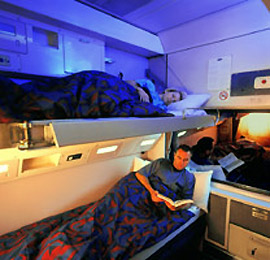
Brisbane - Townsville - Cairns
Queensland Railways (QR) operates excellent passenger trains linking Brisbane, Townsville and Cairns, branded Traveltrain. The trains operate on narrow gauge 3' 6" tracks, which explains why you need to change at Brisbane onto NSW TrainLink's standard gauge (4' 8½") trains to and from Sydney . For more info & online tickets see www.queenslandrailtravel.com.au .
The SPIRIT OF QUEENSLAND is a new 100mph tilt train with Railbed Class flat-bed seats, Premium Economy Class seats and a lounge car. Introduced in October 2013, this is a brand-new 100mph tilting train, see the photos below . For more info see www.queenslandrailtravel.com.au .
The old Sunlander was discontinued in December 2014, replaced by the Spirit of Queensland 100mph tilt train.
BRISBANE-ROCKHAMPTON: There are additional trains between Brisbane and Rockhampton, including a 100mph tilting daytime train.
BRISBANE-LONGREACH: A train called the SPIRIT OF THE OUTBACK runs twice a week Brisbane - Rockhampton - Longreach, with 1st & economy sleepers, economy seats, and restaurant car. 1st class fares now include meals. See www.queenslandrailtravel.com.au for details.
CAIRNS-FORSAYTH: A little 1963-tainless-steel railcar works the Savannahlander train from Cairns to Forsayth at 06:30 every Wednesday with an overnight hotel stop in Almaden, arriving in Forsayth on Thursday evening. It returns from Forsayth at 08:30 on Fridays, also with an overnight hotel stop in Almaden, arriving Cairns 18:40 on Saturdays. A 4-day outback rail experience! It runs March until December, no service in late Dec, Jan or Feb or first few days of March. See www.savannahlander.com.au for timetable, fares & booking.
Children 15 years and under pay half the adult fare, children 3 years and under go free.
A-Choice fare = fully flexible, refundable. U-Save fare = advance-purchase limited availability, no refunds. B-Quick = another advance-purchase fare.
Option 1, buy at www.queenslandrailtravel.com.au
You can check train times & fares and book online at www.queenslandrailtravel.com.au . This can book economy and railbed class.
12go.com is a reliable booking agency, the process is easy, overseas credit cards no problem. 12go can book economy seats but may not be able to book railbed class. Your ticket will be confirmed within 24h and sent by email.
The Spirit of Queensland tilt train
The train has two classes, Railbed class & Premium Economy class. All seats have power sockets and airline-style seat-back TV entertainment systems. All passengers can use the lounge-cafe car, in Railbed class meals are served at your seat.
The Spirit of the Outback
Kalgoorlie - perth, transwa's prospector.
Transwa (formerly known as Westrail) introduced new express diesel trains on the Perth to Kalgoorlie Prospector services in September 2003, running at up to 100mph. Within a few years, track will be upgraded to 125mph (200km/h), making these trains the fastest in Australia. For more info, visit www.transwa.wa.gov.au .
Things to see & do
Sydney is a fantastic city. Take a tour of the opera house ( www.sydneyoperahouse.com ). Wander through the botanic gardens . Visit the observation deck of the Centrepoint Tower ( www.sydneytowereye.com.au ). Take a ferry from Circular Quay to Watson's Bay for fish and chips at Doyle's famous refreshment rooms ( www.doyles.com.au , look for 'Doyles on the beach', for Sydney ferry information see transportnsw.info/travel-info/ways-to-get-around/ferry ). For general city tourist information see www.sydney.com .
Sydney Harbour Bridge Climb
Why not do the incredible Sydney Harbour Bridge climb ? From A$344, you are briefed and equipped for a walk up the girders of Sydney Harbour Bridge, for some fantastic views across the city, from the Pacific Ocean in the East to the Blue Mountains in the West. The bridge climb tour has been operating since October 1998. Book your climb online here or visit www.bridgeclimb.com for more information.
The Blue Mountains
Don't forget to visit the museum in Melbourne's old gaol , www.oldmelbournegaol.com.au . Ned Kelly, Australia's most infamous outlaw, was imprisoned and hanged in Melbourne gaol, and his unique armour was originally displayed there.
Great Ocean Road
Named after the wife of King William IV, Adelaide is a much smaller city than Sydney or Melbourne, and much more relaxed. Admirably well laid-out by its founder, Colonel William Light, the city centre is surrounded by parkland. On Montefiore Hill to the north of the centre, you can see 'Light's vision', where Colonel Light stood to map out his plan for the city. For city visit information see www.cityofadelaide.com.au .
Barossa Valley wine region
Great ocean road by train+bus, every monday, wednesday, friday for just au$ 10.
The Great Ocean Road along the coast from Melbourne is one of the great scenic drives of Australia. You can hire a car and drive it, or there are various 1-day bus tours from Melbourne. But rather than endure a bus for the whole day, just AU$ 10 gets you a 1-day tour on Mondays, Wednesdays and Fridays run by V/Line, the regional train & bus operator, using comfortable trains from Melbourne's Southern Cross station, as follows:
You take the daily 09:10 V/Line train from Melbourne's main Southern Cross railway station to Geelong, arriving 10:07. The train is comfortable and air-conditioned. Economy seats only, no reservation required.
At Geelong, the train connects with a daily air-conditioned V/Line coach leaving from outside Geelong railway station at 10:20 and running via Anglesea and Lorne to Apollo Bay arriving 12:53. No reservation required.
At Apollo Bay, you switch buses and join a V/Line Great Ocean Road air-conditioned sightseeing coach. This runs on Mondays, Wednesdays & Fridays leaving Apollo Bay at 13:25 and running all along the Great Ocean Road via the Twelve Apostles (30 minute stop), Loch-Ard Gorge (15 minute stop), London Bridge (10 minute stop) and Bay of Islands (10 min stop) to Warrnambool railway station, arriving 16:55. No reservation is required for this bus.
At Warrnambool, the bus connects with the 17:36 V/Line train back to Melbourne Southern Cross, arriving Melbourne at 21:15. This comfortable air-conditioned train has first class as well as economy seats, refreshments are available on board. However, on this train a seat reservation is required.
How much does it cost?
Since 2023, a return ticket from Melbourne to Warrnambool, out via the Great Ocean Road sightseeing bus and back on the direct train now costs an amazingly cheap Aus$ 10 (£5 or US$6), after an election pledge to cap transport fares across Victoria (it used to cost around Aus$87, about £50 or US$62). Children 0-3 (inclusive) go free, children aged 4 to 16 go at the concession rate, Aus$5.
You can easily book this trip online at www.vline.com.au . Simply click Plan trip/buy tickets and use the journey planner to book a return ticket from Melbourne Southern Cross to Warrnambool Station, making sure it's on a Monday, Wednesday or Friday. Make sure you select the 09:10 departure from Melbourne to Warrnambool by train+coach+coach via Geelong & Apollo Bay on the outward leg, and the 17:36 direct train from Warrnambool to Melbourne on the return leg. You pay by Visa or MasterCard and collect your tickets at any V/Line sales outlet, including at Melbourne Southern Cross station. If you have any issues booking this, call V/Line on +61 3 9662 2505.
For general tourist information about the Great Ocean Road, see www.visitgreatoceanroad.org.au .
Buy at Amazon.co.uk (UK) or Amazon.com (US)
Alternatively, you can download just the chapters you need in .PDF format from the Lonely Planet Website , from around £2.99 or US$4.95 a chapter.
Australia by Rail from Trailblazer Guides
Accommodation in australia, tripadvisor hotel reviews.
www.tripadvisor.com is a good place to find independent travellers' reviews of the main hotels. It also has the low-down on all the sights & attractions too.
Backpacker hostels in Australia: www.hostelworld.com
www.hostelworld.com : If you're on a tight budget, don't forget about backpacker hostels. Hostelworld offers online booking of cheap private rooms or dorm beds in backpacker hostels in many places in Australia, at rock-bottom prices.
Flights to Australia
1) check flight prices at opodo, www.opodo.com, 2) use skyscanner to compare flight prices & routes worldwide across 600 airlines....

3) Lounge passes
Make the airport experience a little more bearable with a VIP lounge pass, it's not as expensive as you think! See www.loungepass.com
Travel to Australia without flying
For information on how to travel from Europe to Australia without flying, either overland by Trans-Siberian Railway to the Far East then by freighter, or by sea all the way, see the Australia overland page .
H olidays by train in Australia

Alternatively, companies such as Travelbag can arrange independent travel, with flights and trains as required.
Travel insurance & other tips
Always take out travel insurance.
Never travel overseas without travel insurance from a reliable insurer, with at least £1m or preferably £5m medical cover. It should also cover cancellation and loss of cash and belongings, up to a sensible limit. An annual multi-trip policy is usually cheaper than several single-trip policies even for just 2 or 3 trips a year, I have an annual policy with Staysure.co.uk myself. Here are some suggested insurers. Seat61 gets a small commission if you buy through these links.
Get an eSIM with mobile data package
Don't rely on WiFi, download an eSIM with a mobile data package for the country you're visiting and stay connected. Most newer mobile phones can download a virtual SIM card so you don't need to buy a physical SIM, including iPhone 11 & later, see device compatibility list . Maya.net is a reliable eSIM data retailer with a 4.5 out of 5 Trustpilot rating and a range of packages including unlimited data .
Get a Curve card for foreign travel
Most banks give you a poor exchange rate, then add a foreign transaction fee on top. A Curve MasterCard means no foreign transaction fees and gives you the mid-market exchange rate, at least up to a certain limit, £500 per month at time of writing. The money you spend on your Curve card goes straight onto one of your existing debit or credit cards.
How it works: 1. Download the Curve app for iPhone or Android . 2. Enter your details & they'll send you a Curve MasterCard - they send to the UK and most European addresses. 3. Link your existing credit & debit cards to the app, you can link up to two cards with the free version of Curve, I link my normal debit card and my normal credit card. 4. Now use the Curve MasterCard to buy things online or in person or take cash from ATMs, exactly like a normal MasterCard. Curve does the currency conversion and puts the balance in your own currency onto whichever debit or credit card is currently selected in the Curve app. You can even change your mind about which card it goes onto, within 14 days of the transaction.
I have a Curve Blue card myself, it means I can buy a coffee on a foreign station on a card without being stung by fees and lousy exchange rates, just by tapping the Curve card on their card reader. The money goes through Curve to my normal debit card and is taken directly from my account (in fact I have the Curve card set up as payment card on Apple Pay on my iPhone, so can double-click my phone, let it do Face ID then tap the reader with the phone - even easier than digging a card out). I get a little commission if you sign up to Curve, but I recommend it here because I think it's great. See details, download the app and get a Curve card , they'll give you £5 cashback through that link.
Get a VPN for safe browsing. W hy you need a VPN
When you're travelling you often use free WiFi in public places which may not be secure. A VPN encrypts your connection so it's always secure, even on unsecured WiFi. It also means you can select the geographic location of the IP address you browse with, to get around geoblocking which a surprising number of websites apply. See VPNs & why you need one explained . ExpressVPN is a best buy with a 4.7 out of 5 Trustpilot ranking which I use myself - I've signed up as an ExpressVPN affiliate, and if you go with expressvpn.com using the links on this page, you should see a special deal, 3 months free with an annual subscription. I get a small commission to help support this site.
Carry an Anker powerbank
Tickets, reservations, vaccination records and Interrail or Eurail passes are often held digitally on your mobile phone, so it's vital to keep it charged. I always carry an Anker powerbank which can recharge my phone several times over if I can't get to a power outlet. Buy from Amazon.co.uk or from Buy from Amazon.com .
Back to home page
Share this page
Trip to Adelaide
Find the perfect accommodation!
Great location and deals for every budget.
Route Melbourne to Adelaide
Compare travel options and prices to find best route from melbourne to adelaide.
Show bus routes
Show train routes
Show flights
What is the cheapest way to get from Melbourne to Adelaide?
What is the fastest way to travel from melbourne to adelaide, how far is it from melbourne to adelaide, how do i travel from melbourne to adelaide without a car, how long does it take to get from melbourne to adelaide, train, bus or fly from melbourne to adelaide, where can i stay near adelaide, can i drive from melbourne to adelaide, is there a direct bus between melbourne and adelaide, where do i catch the melbourne to adelaide bus from, where does the melbourne to adelaide bus arrive, which airlines fly between melbourne and adelaide, what is the fastest way to get from melbourne to adelaide by plane, how long is the flight from melbourne to adelaide, what stations do trains from melbourne to adelaide arrive at, is there a direct train between melbourne and adelaide, where to catch the melbourne to adelaide train, how much does a flight from melbourne to adelaide cost, how much does a train from melbourne to adelaide cost, how much does a bus from melbourne to adelaide cost, how much does it cost to drive from melbourne to adelaide.
Trips from Melbourne
- From Melbourne to Canberra
- From Melbourne to Perth
- From Melbourne to Ballarat
- From Melbourne to Sydney
- From Melbourne to Geelong
- From Melbourne to Hobart
- From Melbourne to Cairns
- From Melbourne to Alice Springs
- From Melbourne to Brisbane
- From Melbourne to Phillip Island
- From Melbourne to Darwin
- From Melbourne to Gold Coast
- From Melbourne to Portsea
- From Melbourne to San Remo
- From Melbourne to TASMANIA
- From Melbourne to Beijing
- From Melbourne to Singapore
- From Melbourne to San Francisco
- From Melbourne to Banana
- From Melbourne to Honolulu
- From Melbourne to Launceston
- From Melbourne to Newcastle
- From Melbourne to Townsville
- From Melbourne to London
- From Melbourne to Dubai
- From Melbourne to Christchurch
- From Melbourne to Auckland
- From Melbourne to Wellington
- From Melbourne to Queenstown
- From Melbourne to Tokyo
- From Melbourne to Delhi (National Capital Territory of India)
- From Melbourne to Rome
- From Melbourne to Mumbai
- From Melbourne to Paris
- From Melbourne to Los Angeles
- From Melbourne to Hyderabad
- From Melbourne to Athens
- From Melbourne to Barcelona
- From Melbourne to Karachi
Trips to Adelaide
- From Sydney to Adelaide
- From Brisbane to Adelaide
- From Perth to Adelaide
- From Canberra to Adelaide
- From Salt Lake City to Adelaide
- From Port Augusta to Adelaide
- From Glenelg to Adelaide
- From Melrose to Adelaide
- From Casino to Adelaide
- From Alice Springs to Adelaide
- From Katherine to Adelaide
- From Darwin to Adelaide
- From Gold Coast to Adelaide
- From Cairns to Adelaide
- From Edinburgh to Adelaide
- From Manchester to Adelaide
- From London to Adelaide
- From Shanghai to Adelaide
- From Seoul to Adelaide
- From Seattle to Adelaide
- From Meredith to Adelaide
- From Hobart to Adelaide
- From Dublin to Adelaide
- From Atlanta to Adelaide
- From Islamabad to Adelaide
- From Queenstown to Adelaide
- From Munich to Adelaide
- From Beirut to Adelaide
- From Auckland to Adelaide
- From Cairo to Adelaide
- From Chicago to Adelaide
- From Delhi (National Capital Territory of India) to Adelaide
- From New York City to Adelaide
- From Las Vegas to Adelaide
- From Bucharest to Adelaide
- From Dallas to Adelaide
- From Denver to Adelaide
- From Ho Chi Minh City to Adelaide
- From Taipei to Adelaide
- From Johannesburg to Adelaide
Popular routes
- From Dallas to Lubbock
- From Pittsburgh to Gettysburg
- From Fontana to Victorville
- From Reno to Ely
- From Mobile to Pensacola
- From Cleveland to Orlando
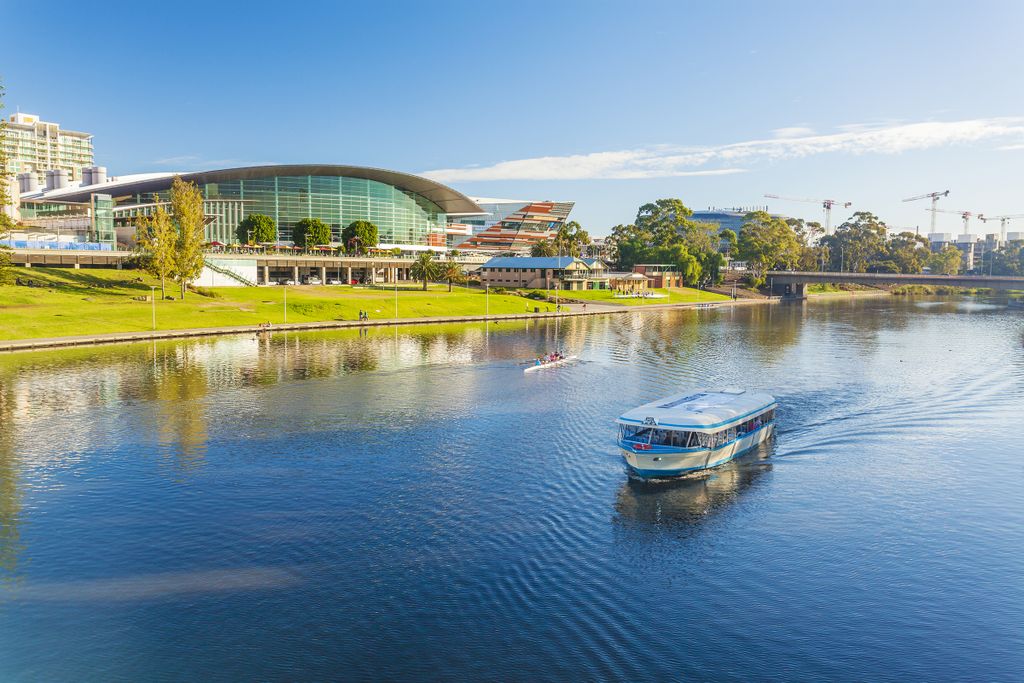
Melbourne to Adelaide
Best options, other options, melbourne to adelaide schedule, transportation from melbourne to adelaide.
- Trains RUB 11,214
- Buses RUB 3,940
- Flights RUB 11,335
- Ferries are not available
- Taxis are not available
- Vans are not available
Facts about the transport from Melbourne to Adelaide
Melbourne to adelaide destination reviews, popular routes, from melbourne.
- Melbourne → Sydney
- Melbourne → Canberra
- Melbourne → Brisbane
- Melbourne → Perth
- Melbourne → Greater Geelong
To Melbourne
- Sydney → Melbourne
- Adelaide → Melbourne
- Greater Geelong → Melbourne
- Perth → Melbourne
- Canberra → Melbourne
From Adelaide
- Adelaide → Perth
- Adelaide → Brisbane
- Adelaide → Darwin
- Adelaide → Kangaroo Island
To Adelaide
- Sydney → Adelaide
- Perth → Adelaide
- Brisbane → Adelaide
- Gold Coast City → Adelaide
- Darwin → Adelaide
Popular Routes in Australia
- Sydney → Brisbane
- Brisbane → Sydney
- Sydney → Canberra
How to get from Melbourne to Adelaide
When you want to get from Melbourne to Adelaide, you have a few options to consider. Traveling between these destinations is possible by different means of transport:
If you’re looking for a quick trip, it’s recommended that you use Flight. However, if you’d rather take your time with a slower, more affordable travel option, you can book a Bus ticket.
The cost of travel will depend on the means of transport you choose for your trip. A flight ticket is the most expensive option - it will cost you about RUB 36,353 . If you want to save on transportation, it’s better to take a train as a train ticket costs as low as RUB 11,214 .
How far is Melbourne from Adelaide?
If you’re traveling by land, it’s important to know the distance from Melbourne to Adelaide. Your trip will be a total of 467 miles (751 km). The flying distance is 499 miles (802 km).
How long does it take to get from Melbourne to Adelaide?
The travel time from Melbourne to Adelaide can vary depending on the mode of transportation you choose. All things considered, the whole journey should take from 2 to 12 hours.
How much does it cost to get from Melbourne to Adelaide?
The cost of the trip from Melbourne to Adelaide varies according to what means of transport you choose for your journey. The most affordable operator is The Overland: travelling by train expect to pay as low as RUB 11,214 for your ticket.
However, if you’re after more upscale travel . The most expensive variant is to opt for a flight - a one-way flight ticket can cost as much as RUB 36,353 .
Here is a chart of the average ticket prices and transportation options available from Melbourne to Adelaide:
- Bus tickets - RUB 3,940 to RUB 5,152 ;
- Train tickets - RUB 11,214 to RUB 11,214 ;
- Plane tickets - RUB 11,335 to RUB 36,370 ;
How many trips per day are there between Melbourne and Adelaide?
Depending on your choice of transportation, the number of daily trips varies.
- Flights from Melbourne to Adelaide depart during the day - there are approximately 25 departures a day.
- Trains always run on a set schedule - there are 1 trains per day.
Which means of transport is the best for the route?
How to choose the most convenient way of travel from Melbourne to Adelaide? In order to make your choice of transportation easier, we asked 1000 users to range their preferences for this route. Here are the results of the poll:
- 85% decided to go for a bus.
- 10% users enjoyed a train ride.
- 5% users took a plane.
- Australia 🎫
- Transport Options
Honest tourism information about Australia
Melbourne to Adelaide train: Timetable, journey time & fare prices
- David Whitley

Melbourne to Adelaide train duration and stops
The Overland train from Melbourne to Adelaide takes around ten-and-a-half hours to complete the journey .
The stops on the Victorian leg of the journey are North Shore Geelong, Ararat, Stawell, Horsham, Dimboola and Nhill . Once in South Australia , the Overland train stops in Bordertown and Murray Bridge .
👇 7 great day trips while you’re in Melbourne 👇

- Great Ocean Road tour – with koalas 🐨.
- Brighton Beach, Moonlit Sanctuary and Phillip Island tour – with penguins 🐧.
- Yarra Valley wine tour – with gin, cider and cheese 🍷.
- Grampians National Park tour – with bushwalks and LOADS of kangaroos 🦘.
- Mornington Peninsula tour – with hot springs bathing 🛀.
- Wilsons Promontory tour – with all manner of native wildlife 🦘🐨.
- Dandenong Ranges steam train ride – plus wildlife at Healesville Sanctuary and chocolate-tasting in the Yarra Valley.
Why not BROWSE THE BEST DEALS – with instant confirmation and hassle-free, mobile-friendly tickets?
Booking melbourne to adelaide train tickets.
For more information on the Overland train, visit the Journey Beyond Rail website . Tickets can be booked online .
Alternatives you may want to consider include taking a flight , catching the bus or hiring a car in Melbourne.
Things to do in Adelaide include walking tours concentrating on North Terrace , Victoria Square , the ghosts of Adelaide Gaol and North Adelaide’s mansions .
Otherwise, try a Torrens River cruise , swimming with dolphins from Glenelg and climbing the roof of the Adelaide Oval .
15 fabulous Adelaide experiences to supercharge your visit
- DOLPHINS 🐬: Swim with wild dolphins, kayak with the resident bottlenose pod or watch them on a dolphin cruise .
- FOOD AND WINE 🍷: Indulge on Adelaide food tour including Adelaide Central Market. Or try a wine discovery tour with tastings at the National Wine Centre. Or the ultimate Penfolds Magill Estate experience with full estate tour & Grange tasting.
- WILDLIFE 🐨: Spot koalas on a guided Morialta nature hike . Or walk from Waterfall Gully to Mount Lofty with entrance to Cleland Wildlife Park .
- CRUISES ⛵: Watch the sun set on a twilight coastal cruise , get to know the city on a Torrens River cruise or take a high tea cruise aboard the Popeye.
- SPORT 🏏: Dare to take on the Adelaide Oval Roofclimb or enter the fabled scoreboard on the behind-the-scenes stadium tour .
- ACTION 🚵♂️: Descend Mount Lofty on a downhill mountain bike tour or kayak along the Torrens River .

If you have found Australia Travel Questions helpful, please book tours and accommodation through our booking partners. It will cost you nothing extra, and the small commissions received help fund more content for the site. Thank you!
More Victoria travel
How long is the Castlemaine to Bendigo drive?
Swim in Lake Glenmaggie near Maffra, Gippsland.
Where should I stop on the Ballarat to Daylesford drive ?
Visit Fairy Park on the Geelong to Ballarat drive .
How long does the Ballarat to Melbourne train take?

Is Adelaide Worth Visiting? 11 Reasons To Say Yes!
M y father is probably not going to speak to me about letting the cat out of the bag; but Adelaide is Australia’s hottest city break destination.
Many people come to Adelaide as a gateway to Barossa Valley, to drive the Great Ocean Road, or to take the iconic Ghan train up to Darwin through the outback, but you might be wondering; is Adelaide worth visiting as a destination in itself?
Adelaide in a modern and vibrant city that has a laid-back, small town feel. Its position makes it a great base for exploring other iconic areas of South Australia, it’s surrounded by stunning beaches, rolling hills and vineyards, and it’s also more affordable than other cities in the South such as Melbourne.
Adelaide has charm, sophistication, history, elegant beauty and a fresh, gentle, fun way of living that doesn’t zap your energy like the big buzzing cities of Sydney and Melbourne do.
This is just a snapshot of why Adelaide is worth visiting, but if you need more convincing, then keep reading to see all the reasons why we love Adelaide!
1. It’s A Beautiful, Breathable City
2. the food capital of australia, 3. the wine capital of australia, 4. there’s a greater adelaide, 5. you can explore the city by bike, 6. tons of festivals and events in adelaide, 7. it has an eclectic lifestyle, 8. it has kangaroo island, 9. amazing sandy beaches, 10. everything is close by, 11. year round good weather, final thoughts, more south australia travel tips, save this to pinterest, reasons to visit adelaide.
Here are eight reasons you should forget Sydney and Melbourne for your next getaway and head to Adelaide.
It may not have the stunning wow factor of Sydney , but Adelaide has a softer gentle beauty with the surrounding hills to the east, beautiful beaches to the west, luxuriously wide boulevards, many parks and gardens, enormous skies and wide-open spaces.
Unlike Sydney and Melbourne , Adelaide offers you space to breathe.
Everything you need is only 20 minutes away and with a population of only 1 million, you can swing and spin with arms wide open while appreciating all it has to offer.
One hour spent exploring the 143-year-old Adelaide Central Market convinced me Adelaide was the food capital of Australia.
It has over 80 stalls, cafes and restaurants all showcasing local produce.
You can watch cheese being made, feast on chocolate, enjoy coffee from an Italian family with a 55 year history in the markets.
Alternatively, buy from green grocers who’ve been operating for more than 35 years. There is even a food tour you can do around the markets.
In the city, highly awarded fine dining restaurants exist alongside pop up bars and food trucks. There’s over 100 pubs in the city and plenty of hip bars and watering holes in arcades and hidden laneways.
I highly recommend Cibo Espresso in Glenelg, Cafe Zuma for breakfast at the Central Markets, and Ky Chow in Chinatown.
There’s nothing I like more during the winter than to sit around a cosy fire on a vineyard with a superb glass of Australian Shiraz.
There are wineries all around Australia and near to the capital cities, but in Adelaide, there are several within an hour’s drive of the city centre.
You’ll find some wine tasting experiences of Australia’s most recognized brands such as Penfolds , Yalumba , Wolf Blass and Jacob’s Creek .
It’s the place where some of the best wine in the country is made. With a nation full of superb wine growers, this is a statement that must be tested.
You’re spoilt for choice: Barossa Valley , Mclaren Vale, Clare Valley and the Adelaide Hills (your boutique stuff). There is no other capital city in Australia that offers you such easy access to many different wine regions.
How can you not love a city where Australia’s best food and wine meet?
If you move just a short distance in any direction from the CBD, you’ll discover a diversity of regions to satisfy any person’s interests: Wine regions, beautiful beaches, historical towns, unusual villages in the hills, abundant wildlife and stunning landscapes.
Most of Adelaide’s beaches are within a 30-minute drive and with the warm climate can be appreciated almost all year round. Glenelg, the main tourist beach is only 12km from town.
When I visited the resident seal waved to me while swimming 5 metres from shore!
Adelaide is an easy city to explore by bike: it’s flat, with beautiful biking trials through gorgeous parklands, and well-marked and safe bicycle lanes on the city streets.
I enjoyed a lovely bike ride along the Torrens River and through the parklands of East Adelaide.
There are plenty of sightseeing places along the way, I preferred losing myself in the stunning Botanical Gardens . The bike path does a loop around the city or you can even cycle out to the beaches.
The best news is that the city of Adelaide hires bikes out for FREE!
Another reason Adelaide is high on our bucket list is the wide variety of festivals and events on offer. You get the party and fun without the maddening crowds.
Now’s the season for the sports mad to experience the thrill of a live AFL game.
Mad March is when you throw your party boots on as it’s the hot festival time.
The most known festivals in Adelaide are the Adelaide Festival , Adelaide Fringe Festival , WOMADelaide , Tour Down Under , and Tasting Australia .
But Adelaide also has many smaller, just as fun, festivals and events such as Splash Adelaide , which focuses on bringing the city’s streets and spaces to life with pop-up street parties and restaurants, performances, night markets, and mobile food vendors.
Discover more fun festivals in Australia
It might have a lot of history, being Australia’s first free settlement, but Adelaide is overbrimming with multiculturalism which is reflected in their suburbs, food experiences and festivals.
German influence is strong in the Barossa Valley and the Adelaide Hills – a must visit suburb is Hahndorf .
The Irish founded the Clare Valley and Italians, Greeks and Asians have a strong influence in the region’s dishes.
My heart bursts every time I think of Kangaroo Island . Kangaroo Island is Australia’s answer to the Galapagos Island and is only two hours from Adelaide, and is as the name suggests, the best place to see kangaroos in Australia (especially the rare red kangaroo).
It’s a remote and undiscovered destination that has stunning beauty, unique and abundant wildlife, awesome sunsets, 4WD drive adventures and no crowds. I’m booking myself in for a month.
Read more: things to do on Kangaroo Island
Adelaide may be a big metropolis city but it’s surrounded by nature, including amazing sandy beaches.
Some of the most popular beaches are Glenelg Beach , Henley Beach and Moana Beach .
To discover some of Adelaide’s hidden gems, head to Maslin Beach , Brighton Beach or Myponga Beach .
Adelaide has a cute nickname as “the 20 minute city” because everything is said to be within 20 minutes from the city centre.
Whether you want to explore wineries, beaches, or the Adelaide Hills, it’s only 20 minutes to the top attractions in the city by public transport.
There is a tram that connects most of the main attractions in the city making getting around a breeze.
Even the airport is only 20 minutes from the city.
Unlike other cities on the South Coast (cough, Melbourne), Adelaide has an all round decent climate which makes it a great destination to visit year round.
In the summer, the weather is warm and dry, with a comfortable average temperature of 29°C (84.2°F).
In the winter, it can get cool, but snow in Adelaide is very rare (you may get a bit in the Hills, but the city is usually dry).
The best time to visit Adelaide though is definitely in the Spring from March to May, as well as the Fall from September to November.
February and March are the busiest months to visit Adelaide and is when you see the most tourists.
June to August is the rainy season and is when you see the least amount of people in Adelaide.
Adelaide is pretty Rad! I’m penciling in a couple of weeks to explore more deeply next time we’re in Australia.
Now your toughest decision is what do you explore first?
As Lonely Planet said when it named it in their Top 10 must visit cities for 2014, it’s a “A gateway to some of Australia’s most accessible wine country, Adelaide is effortlessly chic – and like a perfectly cellared red, it’s ready to be uncorked and sampled.”
Time to uncork it!
Need more inspiration for visiting South Australia? Here are some other helpful guides…
- Romantic ideas in Barossa Valley and Adelaide Hills
- Amazing Food and Wine Experiences Barossa Valley and Adelaide Hills
- Ways to Experience the Natural Beauty in Barossa Valley and Adelaide Hills
- A Visit to Flinders Ranges National Park, South Australia
- Things to Do on the Eyre Peninsula, South Australia
- A 4 Day Road Trip to Kangaroo Island
- Best Road Trips in Australia
- Things to do in Adelaide – a city guide
What are your reasons to visit Adelaide? Share your thoughts in the comments.
![My father is probably not going to speak to me about letting the cat out of the bag; but Adelaide is Australia’s hottest city break destination. Many people come to Adelaide as a gateway to […] My father is probably not going to speak to me about letting the cat out of the bag; but Adelaide is Australia’s hottest city break destination. Many people come to Adelaide as a gateway to […]](https://img-s-msn-com.akamaized.net/tenant/amp/entityid/AA1nYaxY.img?w=768&h=432&m=6)

IMAGES
VIDEO
COMMENTS
Great Southern Rail Journeys are only available in January and December. Book Now See available options. Or Call 1800 703 357. To book this package please call or email [email protected]. Call 1800 703 357. Travel by train between Melbourne and Adelaide aboard The Overland, enjoying a relaxing journey while savouring the comforts and romance of ...
Qantas, Virgin Australia and three other airlines fly from Melbourne to Adelaide hourly. Alternatively, Firefly Express operates a bus from Southern Cross Coach Terminal to Adelaide twice daily. Tickets cost $55 - $85 and the journey takes 10h 15m. V/Line also services this route once a week. Airlines.
The average train between Melbourne and Adelaide takes 10h 27m and the fastest train takes 10h 25m. The train runs, on average, 2 times per week from Melbourne to Adelaide. The journey time may be longer on weekends and holidays; use the search form on this page to search for a specific travel date.
Train travel from Melbourne to Adelaide. ... In 1995, following construction of a new standard gauge rail link between Melbourne and Adelaide, 'The Overland' ran on Broad gauge tracks for the final time, and commenced running on standard (1435mm) gauge via the new, slightly more southerly route via North Shore Geelong instead of via ...
The Melbourne to Adelaide train departs twice a week and takes ten-and-a-half hours. Fares on the Overland train service cost from $115. The Melbourne to Adelaide train should be seen as a practical alternative for non-drivers, not an enjoyable journey in its own right. A Melbourne to Adelaide road trip, whether via the Great Ocean Road or the Grampians, is too much fun.
Adelaide. Melbourne. The average train between Adelaide and Melbourne takes 11h and the fastest train takes 10h 35m. The train runs, on average, 2 times per week from Adelaide to Melbourne. The journey time may be longer on weekends and holidays; use the search form on this page to search for a specific travel date.
The train service from Melbourne to Adelaide is exclusively provided by Journey Beyond - The Overland. This train departs twice a week from Southern Cross station on Mondays and Fridays, with the journey lasting approximately 10 hours and 30 minutes. Ticket prices for the train ride from Melbourne to Adelaide typically range from $70 to $200 ...
The Overland offers a relaxing way to enjoy the trip between the cities of Adelaide and Melbourne. Rail. Duration (in days): 1. From: Melbourne. To: Adelaide (or vice-versa) From. £80. Per person. or Call 01273 320580.
There's no more relaxing way to enjoy the trip between Melbourne and Adelaide than on Great Southern Rail's The Overland. This train pioneered inter-capital rail travel in Australia, when the service first commenced in 1887. 3 times every week, The Overland makes a daylight journey covering 828km (514 miles), providing an ever changing view ...
Travel by train between Adelaide and Melbourne aboard the Overland, enjoying a relaxing journey while savouring the comforts and romance of rail. For over 130 years, The Overland has been a fan favourite for people travelling between Adelaide and Melbourne. ... Still the best way to travel between Adelaide and Melbourne, the Overland offers two ...
The V/Line service is a combined coach and rail service, with trains between Melbourne and Bendigo followed by coach between Bendigo and Adelaide. Buses run both day and night services. Firefly is competitively priced, with regular fares around $65 to $70 and sale fares as low as $35. The Firefly bus, day and night, runs the Dukes/Western route ...
Taking a train to get from Melbourne to Adelaide is a safe, fast, and scenic option to travel the country. On certain routes, there are multiple train departures per day every 10 to 15 minutes. This is typical for intercity travel, while for long distance train routes there are fewer scheduled departures - plan ahead to choose the one that ...
The average train between Melbourne (Station) and Adelaide takes 10h 27m and the fastest train takes 10h 25m. The train runs, on average, 2 times per week from Melbourne (Station) to Adelaide. The journey time may be longer on weekends and holidays; use the search form on this page to search for a specific travel date.
If you wish to travel interstate on public transport, you can do so from two major transport hubs within Melbourne, which each connect with metropolitan public transport services. ... Train Melbourne to/from Adelaide. Great Southern Rail: The Overland. Train direct to/from Southern Cross Station (Melbourne) to Adelaide. From Adelaide customers ...
A beginner's guide to train travel in Australia, with train times, fares, photos & info for train travel around Australia, including the Indian Pacific from Sydney to Adelaide & Perth, The Ghan from Adelaide to Alice Springs & Darwin, the Overland from Melbourne to Adelaide, Countrylink trains from Sydney to Melbourne, Sydney to Brisbane, Sydney to Canberra, and Queensland Railways trains from ...
The Melbourne-Adelaide rail corridor consists of the 828-kilometre (514-mile) long 1435 mm (4 ft 8 + 1 ⁄ 2 in) standard-gauge main line between the Australian state capitals of Melbourne, Victoria and Adelaide, South Australia, and the lines immediately connected to it. Most of its traffic is freight; the only passenger train along the entire route is the twice-weekly passenger service The ...
Travel from Adelaide to Melbourne or vice versa by train and coach with Public Transport Victoria. Find out the route, timetable, fares and booking information for this scenic and comfortable journey via Nhill and Bendigo.
The quickest way to travel from Melbourne to Adelaide is by flying, taking approximately 2 hours and 49 minutes with prices ranging from $70 to $270. If you prefer a more economical option, you can also take the bus which takes about 10 hours and 15 minutes with fares between $9 and $60. Additionally, there is a train service available, with ...
However, if you're after more upscale travel . The most expensive variant is to opt for a flight - a one-way flight ticket can cost as much as USD 385. Here is a chart of the average ticket prices and transportation options available from Melbourne to Adelaide: Bus tickets - USD 42 to USD 55; Train tickets - USD 119 to USD 119;
Qantas, Jetstar and three other airlines fly from Melbourne Central Station to Adelaide hourly. Alternatively, Firefly Express operates a bus from Southern Cross Coach Terminal to Adelaide twice daily. Tickets cost $55 - $85 and the journey takes 10h 15m. V/Line also services this route once a week. Airlines.
Regional Express, Qantas and three other airlines fly from Adelaide to Melbourne hourly. Alternatively, Firefly Express operates a bus from Adelaide to Southern Cross Coach Terminal twice daily. Tickets cost $55 - $85 and the journey takes 9h 50m. Airlines. Qantas.
The Overland train from Melbourne to Adelaide takes around ten-and-a-half hours to complete the journey. The stops on the Victorian leg of the journey are North Shore Geelong, Ararat, Stawell, Horsham, Dimboola and Nhill. Once in South Australia, the Overland train stops in Bordertown and Murray Bridge.
Adelaide has charm, sophistication, history, elegant beauty and a fresh, gentle, fun way of living that doesn't zap your energy like the big buzzing cities of Sydney and Melbourne do.